Text
About Last Knight: The Famous Face-off of Josef Mencik
The townspeople all loved Josef, he was courteous, kind, and generous with all his neighbors. The children delighted in seeing him ride into town and loved hearing his stories. The only thing that could be better was visiting his home, filled with all manner of unique items with tales of their own that Josef was more than happy to tell. Josef Mencik was a historian, but he immersed himself in the past in ways that went far deeper than paper and ink. He may have been born in a more modern age but in his daily life Mencik was the last of the medieval knights.
As dedicated as Mencik was to history, he was extremely secretive of his own and there is almost nothing known about his early days. He never shared the names of any family members, his birthdate is a mystery, and there is no known record of where he was born with historians only able to narrow down that he was most likely born in the Böhmerwald region of Czechoslovakia. In approximately 1911 he ventured out into the world and set his sights on an aged castle in Dobrš. He decided to make it his own, but this was not going to be an easy task. The castle had been standing since the 14th century and when Mencik purchased it it was a ruin, severely damaged by a fire and countless rainstorms that left it a shell of its former self. But in this broken structure Mencik saw his ideal home and after purchasing it he began the long road to rebuilding it.

Böhmerwald region of Czechoslovakia via 1930s. Image via Wikipedia Commons.
Mencik’s idea of bringing his castle back to its glory days was meant in the most literal sense. He lived with no electricity, no plumbing, absolutely nothing representing the comforts available to him in the early 1900s. Where modernity was absent, it was replaced with beauty. The halls were lit with candles and torches and as time went on Mencik filled his home with rare antiques turning it into a literal living history museum, a time capsule of the days long past that he happily shared with anyone who wanted to see the collection of treasures. This full embrace of the medieval age extended far beyond a refurbished home and an extensive antique collection. Mencik lived his life as closely as he could to a knight, traveling on his beloved thoroughbred horse and wearing fine suits of armor crafted in France. Some accounts state that he even had a moat around his castle….filled with wooden alligator sculptures.

Josef Mencik in full armor. Image via DannyDutch.com.
Like so many parts of his past, it is unclear if he ruled his private kingdom alone. According to some accounts Mencik was married to a woman named Ema Mencikova and that they may have had two children, but this has not been proven. What is well known is that everyone who knew Mencik thought very highly of him. By all accounts he treated everyone with respect, was always willing to help anyone in any way he could, and he enjoyed spending time with his friends and neighbors. He was a regular patron of the local taverns where he would socialize with everyone, ending every visit with his personal ritual “to swallow a whole herringbone, which he then drank with a good glass of rum and then shouted menacingly."
Everyone who knew Mencik personally knew of his genuine character, but his actions on one particular day in 1938 would make sure his story was told for generations.

Images of Josef Mencik on his horse. Image via DannyDutch.com.
In an early act of aggression, in 1938 Nazi Germany moved to invade Czechoslovakia in order to annex the predominantly German region of Sudetenland. As the Germans crossed the border through Bučina they were not anticipating any resistance, but what they were met with was more stunning and confusing than they could have imagined. As they crossed they were met by Josef Mencik, seated high upon his horse, dressed in full armor, and holding a very large halberd. He met them standing strong, ready, and defiant, but he also met them alone. As the crushing, modern machines of war rolled closer to the knight he did not flinch and he stood taller as they became more confused as to what exactly they were all seeing. Unfortunately, there is no written account to tell us about the words exchanged between the knight and the Nazis, but what is known is that instead of engaging or attacking Mencik, they all simply hesitated for a short while before continuing to march past him. As they went by some Nazi soldiers tapped their helmets at him, a signal that said they believed that Mencik was simply a delusional man not to be bothered with. As they moved past Mencik they walked into an early chapter of a war that would tear the world apart.
There are many differing opinions about the actions of Mencik against the Nazis with some feeling it was an act of pure bravery while others feel it was foolish. Regardless of opinions, it is technically true that he did successfully defend his castle home which was never taken during the war. In 1945 though, the fortress that Mencik brought back to life and made into a home where he welcomed everyone with open arms, was removed from his hands when the structure became part of the nationalization by the new Communist government. The last medieval knight Josef Mencik died only a few days later in November 1945 and was estimated to be in his late seventies.
For all his living days Mencik sought to bring the past back to life, not just for himself but also for the present to learn from and enjoy. Although he was probably heartbroken by his home becoming nationalized, today his castle is open to the public and serves as a museum, welcoming curious visitors just as he did. Josef Mencik, the last knight, passed away nearly eight decades ago but his private kingdom, his history lessons, and his story of bravery in the face of danger have withstood the test of time far longer than he could have dreamed.

The remnants of Mencik's castle and more recent additions. Image via Michal Klajban / Wikimedia Commons CC BY-SA 3.0
*************************************************************
Sources:
Josef Mencik: The Last Knight Who Stood Up to the Germans In WWII by Samantha Franco. War History Online. January 11th 2023. https://www.warhistoryonline.com/world-war-ii/josef-mencik.html
Josef Mencik – History’s Last Knight Stood Against the Nazis by Travis Pike. Sandboxx.us. November 14th 2022. https://www.sandboxx.us/news/josef-mencik-the-last-knight/
Josef Mencik-the Czech Don Quixote. WWII Forums Gateway to the Second World War. November 18th 2021. http://ww2f.com/threads/josef-mencik-the-czech-don-quixote.76341/
#husheduphistory#featuredarticles#history#forgottenhistory#truestory#strangehistory#weirdhistory#historyclass#truth is stranger than fiction#medieval#medieval knight#the last knight#JosefMencik#czechoslovakia#CzechHistory#wwii
0 notes
Text
Pieces at Peace: A Sampling of Stories and Stones for Long Lost Limbs
Tombstones are endlessly fascinating for the living. Etched in stone, decorated with their own alphabet of symbols, and telling the names (and sometimes a bit of a story) of those who walked the ground before us. We are as curious about these stone last pages in the book of life as we are about the time the body spent on earth with us. While death is promised to all, a formal burial is not. But, sometimes there are burials not for a person, but for a piece of them.
Stretching across thirty-one acres of Newport, Rhode Island are the Common Burial Ground and Island Cemeteries. The Common Burial Ground was founded in 1665 and contains 7,986 known dead from all walks of life and from multiple centuries. The number of actual inhabitants is likely higher though with hundreds more lost to the soil due to time, vandalism, and the fact that some earlier markers were simple wood planks that have long since disappeared.
By 1786 stone tombstones were heavily used and one such stone in the Common Burial Ground belongs to the Tripp family, which had to be used much earlier than anyone hoped. Wait and William Tripp were only ten and twenty-two months old when they were buried under their double headstone in 1780 and 1784. Two years later they were joined by their mother, but only part of her. Desire Tripp was the wife of William, a tanner, and they lived together in a “Large and commodious dwelling house” in Newport. On February 20th 1786 her arm was amputated by Doctor Isaac Senter who noted that the amputation took place and that the cost equated to approximately one month income, but sadly there is no record as to why her arm was amputated. On the tombstone of her children there are two carved faces of cherubs but in the center of the stone there is a carved arm to represent the arm of Desire Trapp also laid to rest at this location. Noted in an inscription along with the names and dates of she and William’s children, the epitaph reads “Also his Wifes/Arm Amputated Feb 20 1786”

The tombstone of Desire's children and her arm. Image via Hopkins vastpublicindifference.com.
While it was highly unusual for a woman to have their arm amputated and to have it memorialized on a tombstone, Desire Trapp is far from the only person to have their limb buried in its own grave.
In 1898 Richard Bertram Barrett of San Jose, California was thirteen years old and living a normal life, until one day during a hunting trip he had a most unfortunate encounter with a shotgun. The shotgun blast damaged half of his left arm beyond all repair and the decision was made to amputate. The arm was buried under a tree in Hacienda Cemetery and has its own stone marker reading solemnly, “Richard Bertram Bert Barrett His Arm Lies Here May it Rest in Peace.”
Barrett went on to lead a very successful life, eventually becoming the Chief of Sanitation for the Santa Clara County Health Department and lived to see a road named for him in the same cemetery where his arm was buried. When he passed away at the age of seventy-four he was also buried, but not with his arm. Barrett’s final resting place is Oak Hill Memorial Park, a full eleven miles away from where his arm was buried sixty-one years earlier. Today the arm has become a part of local folklore with stories saying that the arm can be seen wriggling on the ground on Halloween night.
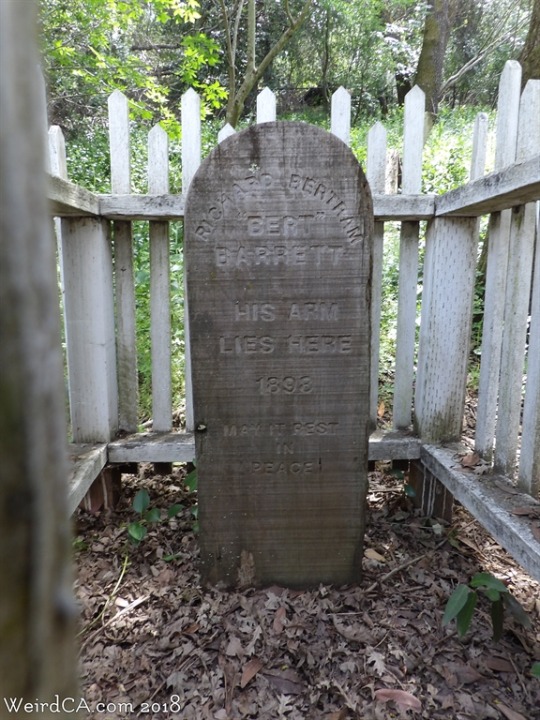
Grave of Bert Barrett's arm. Image via Weirdca.com.
In some ways the Stanley Settlement cemetery in rural northern Georgia can double as a history book of its home of Fannin County with a church and burials dating back to the mid-1800s. Among the interred are Elisha Stanely and Elv Evan Hughes, the first people to be buried here, murdered for refusing to join the Confederate army and both thrown into a single grave. It is Elisha’s son Adolphus Buel Stanley though who has the honor of having one of the more bizarre burials inside Stanley Settlement. A flat stone simply reads “The arm of Buel Stanley 1864-1946 amputated 1915 caused by fishing with dynamite in Toccoa River below Stanley Cemetery…” it goes on to inform the reader that in 1946 Stanley did not join his arm in death. Instead “…His body is buried at Macedonia Church of Christ.”

Grave of the arm of Buel Stanley. Image via Historic Rural Churches of Georgia by Tom Reed.
Losing a limb is not typically something that anyone wants, but when Captain Samuel Jones of Washington, New Hampshire learned he was going to have to part ways with one of his legs he decided he was going to make the best of it. It was 1804 when the captain was doing some construction work and his leg somehow became trapped between a building and a fence. He was eventually freed but his leg had become so mangled that it could not be saved. Captain Jones was also the owner of a local tavern so while waiting for the doctor to arrive his friends took him to the tavern and they all drank to their heart’s content. Once the leg was removed (and Smith was sober) he decided he was not done saying goodbye and decided to throw his leg a full funeral including guests and a proper burial. The leg was interred at the local cemetery, but one day some local college kids decided they wanted to steal the tombstone. After it was located in a dorm the stone was set into the ground in concrete to ensure it would never disappear again. The rest of the life of Captain Jones gets very murky, and it is believed that he ended up in Boston or Rhode Island. He was not buried with his leg.
There have been many reasons and theories as to why someone would want to properly bury their limbs, sometimes with a full funeral. According to Captain Jones, he felt that burying the leg would prevent him from feeling something doctors were aware of but could not explain, phantom leg pain. While this might have seemed funny, this discomfort where someone can still “feel” pain in their missing limb was (and is) very real and in 1878 farmer Benjamin Waldron experienced exactly what the captain was concerned about.
Benjamin Waldron was a twenty-five year old Idaho farmer and in 1878 he was working when his leg got trapped in a thresher, completely destroying it. He also went on to give his leg a proper burial in Samaria Cemetery, complete with a tombstone engraved with the image of a leg, the date of the amputation, and his initials. But something didn’t feel right after the burial, Waldron complained of pain, feeling it radiate from the leg that was no longer there, and saying that it felt uncomfortably twisted. When Waldron could not bear it anymore the leg was exhumed and sure enough, when the leg was buried it was placed in its grave at an unusual angle. Once it was re-buried in a better position Waldron finally felt relief and never felt the phantom leg pain again. Waldron finally joined his leg in the afterlife in 1914. He was also buried in Samaria Cemetery, but in a different location than his demanding leg.

Graves of Waldron and his leg. Image via Speaking of Idaho by Rickjust.com.
Waldron is not alone in his experience of feeling his disconnected limb from beyond the grave. Located in Mesquite, Texas there is a family cemetery called the Z. Motley Cemetery, serving as a permanent place of rest for members of the Motley family who still maintain it to this day.
In 1894 John Motley caught his arm in some gin machinery and as a result the seventeen-year-old was forced to live with only one arm. The arm was buried at the family cemetery but like Waldron, the young man knew something did not feel right about the arm he no longer had. He complained of feeling like there were ants crawling all over his skin. The arm was exhumed and shockingly they found that there was a way for bugs to get in and out and at the time of the exhumation they found the arm covered with ants. The arm was taken, sealed in an air-tight box, and reburied. Motley said he never felt the crawling phantom sensations again.
As luck would have it (or not), John Motley is not the only member of his family to have a separated limb buried in their family cemetery. In 1911 G.C. Motley was riding a horse when the animal took off causing him to fall and get his foot trapped in a stirrup. The injured foot became badly infected and doctors amputated it, giving it a resting place in the same Motley family cemetery as John’s arm.
Both G.C. and John Motley were buried in separate plots from their dearly departed limbs.

Marker for the Z. Motley Cemetery. Image via Nicolas Henderson Flickr CC BY-NC-SA 2.0
The phantom pains and sensations felt by Benjamin Waldron and John Motely and feared by Captain Samuel Jones were one factor in the burials of their limbs, but for others the need for a proper sendoff was rooted in a much more spiritual belief. Judaism, Islam, and Christianity all have varying beliefs on the burial of limbs with some faiths believing it is required to bury the limbs in a grave intended for the person when they pass or in a grave specifically for limbs. Some believe that even though the limbs are to be buried, they are not entitled to the same ceremony and prayers as a whole body. According to some Christian belief systems, the limb was required for the soul to be complete in the afterlife where it would be reunited with its owner, leading to scenarios where limbs were exhumed only to be re-buried with their person.
Perhaps it is this lack of reunion that led to the legend of Richard Bertram Barrett’s arm to come crawling out every Halloween night…it’s still looking for its human buried eleven miles away because it wants to be reunited so it too can rest.
Evidence of amputations and limb burials go back tens of thousands of years. Whether carried out at a sacred burial location or marked with a professionally engraved tombstone detailing some bad timing with dynamite, this notion, this importance, this reverence in honoring all parts of the person has endured over millennia, adapting and evolving alongside the same human creatures the practice honors. Buried alone or with family members, there are stones all over the world that speak to the feeling that even the pieces deserve peace.
****************************************************
Sources
You’ve GottaHhand it to Them: A Look at Limb Graves by Robyn S. Lacy. Spade and the Grave Death and Burial Through an Archaeological Lens. April 4th 2021. https://spadeandthegrave.com/2021/04/04/youve-gotta-hand-it-to-them-a-look-at-limb-graves/
There Are Centuries-Old Grave Sites Just For Amputated Limbs That You Can Still Visit by Laura Allan. Ranker. September 23rd 2021. https://www.ranker.com/list/grave-sites-for-amputated-limbs/laura-allan
Object Lesson: Desire Tripp and her Arm’s Gravestone by Nicole Belolan. Common Place the Journal of Early American Life. https://commonplace.online/article/object-lesson-desire-tripp-arms-gravestone/
History Bytes: Common Burying Ground. Newport Historical Society. February 25th 2016. https://newporthistory.org/history-bytes-common-burying-ground/
Stanley Church of Christ. Historic Rural Churches. https://www.hrcga.org/church/stanley-church/
Waldron's Leg by Rick Just. October 30th 2020. https://www.rickjust.com/blog/waldrons-leg
The Arm of Buel Stanley. Atlas Obscura. January 5th 2021. https://www.atlasobscura.com/places/the-arm-of-buel-stanley
Grave of Captain Jones's Leg. Atlas Obscura. August 16th 2017. https://www.atlasobscura.com/places/captain-jones-leg
Grave of Bert Barrett's Left Arm. Atlas Obscura. January 12th 2017. https://www.atlasobscura.com/places/grave-of-bert-barretts-left-arm
#husheduphistory#featuredarticles#history#forgottenhistory#weirdhistory#strangehistory#tragichistory#historyclass#truestory#truth is stranger than fiction#burials#limbburials#famousgraves#horrorhistory#scaryhistory#cemeteries#tombstones#gravestones#headstones#graveyards#graves
1 note
·
View note
Text
Death Defied: The Multiple Murders of Michael Malloy
Michael Malloy was on the floor again. Day after day he came into Tony Marino’s speakeasy on Third Avenue in New York City, drank himself into a black hole, and passed out only to eventually stand back up and keep drinking. Malloy did this often but the problem was that he had stopped paying for his drinks…and Marino was getting tired of it. He thought he had a plan for getting the money he felt he was owed. He thought it was going to be easy. He was very, very wrong about Mr. Michael Malloy.
The details on Malloy are scarce. He was originally from Ireland and somehow made his way to New York City where he supposedly spent a short amount of time as a fireman before becoming homeless and wandering the streets, occasionally sweeping alleys and always willing to be paid in alcohol instead of coins. People assumed him to be about sixty years old but the only definite thing about him was that he could normally be found with a glass in hand until he could no longer stand on his feet.
In July 1932 Francis Pasqua, Daniel Kriesberg, and owner Tony Marino stood inside the speakeasy watching the Irishman slump over the bar. Business was getting rough for Marino, and it was Pasqua who offered him a solution, why not take a life insurance policy out on Malloy, claim to be family, and take the policy money once Malloy was gone? Pasqua was an undertaker by trade and he told Marino that after the man inevitably drank himself to death he would “take care of the rest.” The suggestion might have been shocking except that this was not a new scenario for Marino. One year earlier the ruthless speakeasy owner befriended a homeless woman named Mabelle Carson and somehow convinced her to take out a life insurance policy that named him as the beneficiary. On a freezing winter night Marino forced her to drink a large amount of alcohol and once she passed out he brought her to a building where he stripped off her clothing, soaked her and the mattress in ice water, and left her under an open window to die. The scheme succeeded and Marino easily collected the $2,000 from Carson’s policy. It worked once, and Marino and Pasqua had no reason to think it could not work again, especially when it came to someone like Malloy who had no connections to anyone and who everyone suspected was only a few sips from death every day. They raised their glasses and sealed the deal between them.
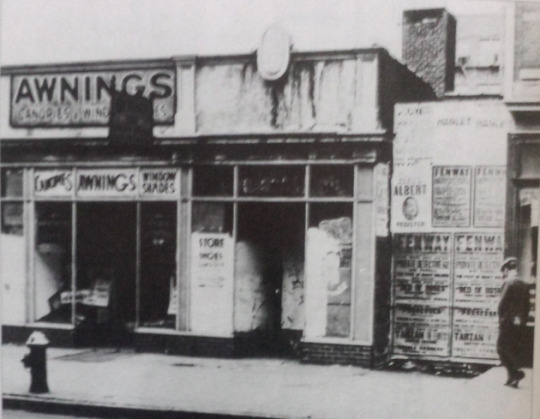
The location of the speakeasy run by Tony Marino on Third Avenue in New York City. Image via wikipedia.com.
Over the course of five months Pasqua, paid accomplices, and a shady insurance agent were able to obtain three different life insurance policies from Prudential Life Insurance Company and one with Metropolitan Life Insurance Company. They also recruited more assistants for the plot with Pasqua getting one of Marino’s bartenders, a man named Joseph Murphy, to act as next of kin after Malloy took his last sip and hit the bar floor for the last time. Each of the involved would split the $3,576 from the insurance policies (approximately $54,000 today.) What could possibly go wrong? They were about to find out.
When Malloy staggered into Marino’s bar on a cold December night the owner had some wonderful news for him, he now had an open-ended tab. He was told that business had gotten more competitive, forcing the owner to loosen the rules, and Malloy was delighted to take advantage of it. He drank shot after shot..drink after drink…for hours…until he finally thanked Marino for his hospitality and decided to call it a night. He left the bar promising to be back and he kept his promise, returning the next night for another drinking session. But to the conspirator’s dismay the second night was only a repeat of the first and after several hours Malloy again walked out promising to see them soon. After a third night of pouring a massive amount of alcohol down Malloy’s throat the concern began to sink in. They were paying for the life insurance policies but now they also lost a substantial amount of money on three nights of nonstop alcohol to a man they were certain would not survive the first. When he entered the bar on night four exclaiming “Boy ain’t I got a thirst?” they knew something else had to be done.
One of the conspirators went to a local paint shop and bought some cans of wood alcohol, an extremely toxic substance used in paint thinner, pesticides, cleaning solutions, and fuel among other things. The first few shots that cascaded down Malloy’s throat were cheap whiskey, but once he was too far gone to tell the difference Marino made the swap. These were not shots laced with the wood alcohol, these were full shots of ONLY wood alcohol. Malloy took shot after shot of the poison and then, to everyone’s amazement, he left on his own two feet. The following night Malloy returned and the process was restarted, whiskey for a while, then the swapped shots. Once again Malloy drank to his heart’s content and walked out a fully living, fully breathing man. Then one night something was different, after multiple shots of pure wood alcohol Malloy dropped to the floor. Finally, the murderous group thought their plan was falling into place as they watched their target’s chest slowly rise and fall. He still had a pulse but it couldn’t be long now, so they waited and watched him believing he was finally approaching death. Until he started snoring. Hours later Malloy woke, rubbed his eyes, and requested some more of the “old regular” to drink.
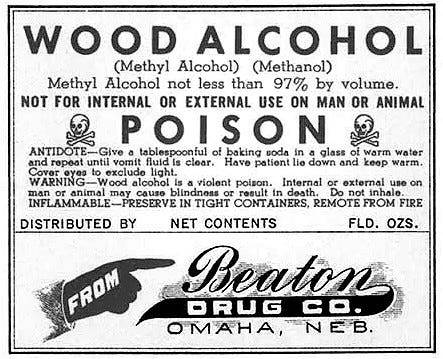
Label for wood alcohol. Image via Medium.com.
As time wore on so did the cost of this ploy. Purchasing the wood alcohol, the insurance payments, and Malloy’s running bar tab was running Marino’s speakeasy into the ground and the group of them decided they needed a new plan before facing financial ruin. The group had gained some more accomplices and some suggested shooting or beating him and getting it over with but Pasqua suggested something to stay on the same route of subtlety. On his next visit they fed Malloy oysters laced with poison. He ate them with glee and washed shell after shell down with more shots of wood alcohol. Next, he was fed sardine sandwiches made from rotten sardines and filled with tiny sharp pieces of metal. He devoured it and asked for seconds. With desperation setting in Marino went back to his old methods and suggested they freeze him to death as he had done with Mabelle Carson. It was now deep into winter in New York City, surely if poison and sharp metal slivers couldn’t do it the cruel cold night would. They waited until Malloy passed out from drinking, hauled him outside through the snow and threw him onto a park bench. They tore off his shirt, drenched his unconscious body with water, and left him there to die a slow death. It was a surprise when Marino showed up to his speakeasy the next day and found Malloy in his basement. Murphy let him in when he showed up complaining of a “wee chill” half a mile from where they left him to freeze.
As the desperation to kill Malloy got stronger the plans to carry out the act became more unhinged. As the new year came and went and February arrived in New York City the seemingly ever-growing crew of people who signed up to be part of Michael Malloy’s death started throwing ideas into the air. One man named John McNally suggested running him over with a car and another accomplice John Maglione chimed in, claiming he knew a cab driver who would commit the deed, for a price of course. When Harry Green pulled up to the speakeasy a small crew of conspirators piled in carrying the heavily inebriated body of Malloy. They brought him to a quiet road and two of the men got out, dragged him down the road and held him up, arms outstretched, and prepared to leap out of the way last minute to avoid meeting death themselves. Green sped down the street with Maglione in the back seat, bracing himself for the impact of Malloy’s body. But it didn’t happen. Once the men let go of him and ran, Malloy somehow also jumped out of the way of the speeding car at the last second not once…but twice. Finally on the third attempt it all went according to plan. The men holding Malloy up leapt out of the way, Malloy stayed, and Green hit him head on. To be sure he was a goner the cab driver backed up over him in the street. The group of killers were certain the deed was done, but they could not check to be sure, another car was approaching and they all scattered before anyone could lay their eyes on the body of Malloy.
For days no one saw Malloy in the speakeasy, but there was a problem. The one member of the dubious plot tasked with finding his body could not find him. He called morgues and hospitals claiming to be looking for his brother so the death could be confirmed and everyone could finally get their money from his insurance, but no one had any record of Malloy.
Five days later the door to Marino’s speakeasy swung open. In walked Michael Malloy. Battered, beaten, and saying he had no memory of what happened, only that he was drinking whiskey, some bright lights, and then waking up in Fordham Hospital desperate for a drink.
On February 21st 1933 the gang had had enough of the resurrecting Michael Malloy. By now the money was going to be split so many times and they had spent so much trying to kill him that it wasn’t even going to be a payoff as originally intended. Now it was just the point, Malloy had to die. After another night of heavy drinking, Malloy finally passed out and a group of the man dragged his body to a tenement building less than I mile away and brought his body into a room. They threw him down, wrapped his head in a towel, and stuck a long rubber tube in his mouth. The other end of the tube was attached to a gas light fixture. The gas finally accomplished what poison, metal, nature, and a car could not do. Michael Malloy was finally dead.

The room where Michael Malloy met his end. The arrow point to the gas pipe where the rubber tube was attached. Image via truecrimeedition.com.
Pasqua had a doctor friend who was willing to write a fake death certificate citing pneumonia as the cause of death and the man playing the part of Malloy’s brother went to claim the insurance money as soon as he could. When the agent asked to see the body they told him he was already buried. They whole murderous plot got all of them a grand total of $800. Marino bought himself a new suit with the money.
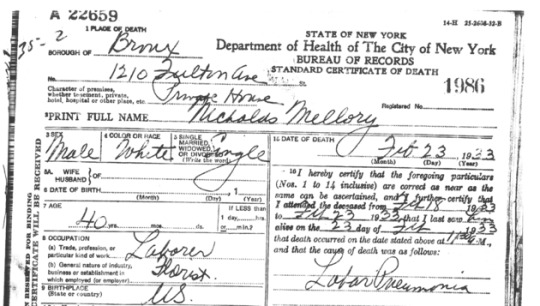
The death certificate of Michael Malloy reading pneumonia as a cause of death. Image via wikipedia.com.
They may have thought the story of Michael Malloy was over, but they were unbelievably naïve to think so. There were too many people involved in the plot combined with the fact that although Malloy was homeless and perpetually drunk, people knew him. When news spread that Malloy was dead it raised some eyebrows and the stories of him surviving massive amounts of alcohol, enduring a freezing night, and walking away from being run over had earned him some nicknames and an almost folklore-like reputation. People wanted to know what finally killed “Iron Mike” and soon the police began asking questions. They learned about the supposed “pneumonia”, they learned about the insurance policies and how Malloy was quickly buried, and they decided they had enough information to resurrect Malloy for real. His body was exhumed, examined, and there was no evidence of pneumonia, but there was a lot of evidence of carbon monoxide in his system. When the police questioned the doctor who wrote the death certificate and the cab driver who ran over a man for the price of $150 they told them everything. The next people the police would be speaking with were the people at Marino’s speakeasy.
The arrests happened fast. The doctor was released on bail, the cab driver spent a short time in jail, but Frank Pasqua, Tony Marino, Daniel Kriesberg and Joseph Murphy were all arrested and walked into court facing charges of first-degree murder. They were all convicted, all sentenced to death, and were all shipped to prison at Sing Sing.
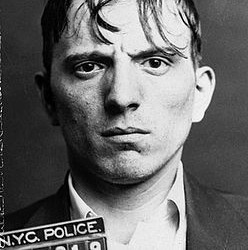
Mugshot of Tony Marino. Image via wikipedia.com.
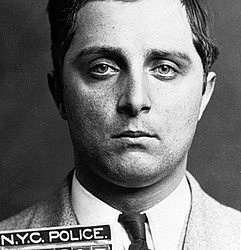
Mugshot of Francis Pasqua. Image via wikipedia.com.
On June 7th 1934 and July 5th 1934 Pasqua, Marino, Kriesberg, and Murphy were all executed by the electric chair, and it only took one try for each of them to depart this world.
**********************************************
Sources:
The Man Who Wouldn't Die by Karen Abbot. Smithsonianmag.com. February 7th 2012. https://www.smithsonianmag.com/history/the-man-who-wouldnt-die-89417903/
Michael Malloy: The Man Who Wouldn’t Die by Kaushik Patowary. Amusingplanet.com. August 21st 2020. https://www.amusingplanet.com/2020/08/michael-malloy-man-who-wouldnt-die.html
The American Rasputin by Dale M. Brumfield. Medium.com. March 20th 2020. https://medium.com/lessons-from-history/the-american-rasputin-a509a4c8de53
The Murder Plot of "Iron" Mike Malloy. Truecrimeedition.com. June 16th 2021. https://www.truecrimeedition.com/post/mike-malloy
#husheduphistory#featuredarticles#history#forgottenhistory#strangehistory#weirdhistory#tragichistory#historyclass#truth is stranger than fiction#truestory#NewYorkCityHistory#MichaelMalloy#truecrime#horrorhistory
1 note
·
View note
Text
The Wrath of Rampjaar: The Death and Destruction of Johan De Witt
The 1600s was a difficult chapter for human life. All over the world wars tore at the seams of land and families, and those that did not fall in battle found themselves vulnerable to falling from disease and plague brought on by forces that could not yet be understood. Many things that could not be explained resulted in further violence, fanaticism, death, and destruction dealt from one hand only to be horrifically felt by the other. Breakthroughs in science, exploration, and the arts collided with religious extremism and prejudice as humanity as a whole spun on, seemingly with chaos in every corner.
The Netherlands were one part of the world with turmoils erupting within their borders. In 1672 the country formerly known as the Dutch Republic was seeing the end of the “Dutch Golden Age” with simultaneous wars with England, France, and two German cities. The year 1672 would enter the history books as the Rampjaar, The Disaster Year. The Dutch people coined a phrase to describe this most unfortunate time: “The people were irrational, the government helpless, and the country beyond salvation.”

Allegory of the Disaster Year by Jan van Wijckersloot (1673). Image via Wikipedia.
Although it was obvious there were multiple problems facing the Dutch Republic in the 1672, some believed the problems took root decades earlier. William II Prince of Orange died of smallpox in 1650 leaving the Dutch with no official leader (referred to as a Stadholder.) It was this same year that Johan De Witt began to make his mark in the politics of the region. Johan’s family were bitter rivals of the Oranges and as De Witt began to move up the political ladder he allegedly (with the help of his powerful father who spent time in prison for his involvement in a coup d'etat of William II) quietly made moves and had words written into political documents to keep the young William III or any member of the Orange family from ruling. This allowed wheels to be set in motion to form a fully Republican regime with De Witt at the helm. After holding a number of high-standing positions he was elected to the role of Grand Pensionary of Holland in 1653, essentially making him the ruler of all Dutch provinces.
By the time the 1672 Year of Disaster loomed over the Dutch Republic the people had already endured enough war and horror to last a lifetime under the eye of Johan De Witt. There were the Anglo-Dutch Wars which threatened the land, but De Witt remained focused on the sea, taking every step possible to protect the economic interests in shipping and trading that filled his pockets while paying little mind to the forces surrounding the Dutch at their front doors. He also made it a point to delay the appointment of William III as captain general. The stubbornness of De Witt would have deep consequences when in May 1672 Louis XIV invaded the Dutch Republic, thus beginning the third Anglo-Dutch War.

Portrait of Johan De Witt by Adriaen Hanneman (1652). Image via Wikipedia.
As troops moved straight into the heart of their homeland the exhausted Dutch people felt betrayed by their leadership and all eyes turned to Johan De Witt. Some were content to simply, but loudly, voice their opinions that the House of Orange should take back their power by any means necessary. Others showed their feelings of anger and betrayal in much more aggressive ways. On June 21st 1672 Johan De Witt was attacked by a man who was armed with a knife and an intent to kill. The assailant did succeed in brutally stabbing him, but he survived. Johan’s brother Cornelis was also feeling the pressure of the simmering public and on July 24th he was arrested under charges of treason against the House of Orange. He was brought to prison in The Hauge where he was tortured in order to obtain a confession. While his brother was recovering from being nearly assassinated, Cornelis was refusing to confess to any wrongdoing and was eventually sentenced to exile.
Being attacked with a malicious blade changed De Witt and after a lengthy recovery he resigned from his position on August 4th 1672. At the time of his resignation his brother Cornelis was still wallowing in prison with his exile looming. On August 20th Johan visited his brother at the prison to assist him and see him off on what was supposed to be his date of forever departure from his homeland. It is unknown what the pair discussed that day, but it is almost certain they had no clue what was about to happen. Yes, Johan resigned and Cornelis was exiled, but the Dutch people were not ready to let the brothers walk peacefully away into a new chapter while they were left with suffering and debt that could follow them for generations. As the brothers talked in the prison they were attacked by a mob that were set on tearing them limb from limb.
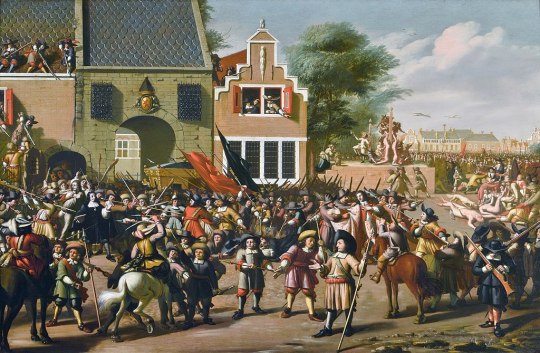
The Murder of the de Witt Brothers by Pieter Fris. Image via Wikipedia.
What unfolded was a scene that was feral, ferocious, and that has gone down in history through eyewitness accounts and multiple pieces of art. The mob ravaged the De Witt brothers. They were dragged into the street, shot, stripped of their clothing, and taken to the public gallows. If the brothers thought their end would be found in a broken neck at the end of a hangman’s noose they were terribly wrong. Once strung up the mob began to take souvenirs. Some accounts report that their eyes were stolen, others say they were later cut into pieces and distributed to the masses, and while that is up for debate one thing that is certain is that their bodies were sliced open, their livers stolen, and the organs were then roasted and consumed by those in attendance. After a lifetime of prestige and twenty years in power, Johan De Witt departed life alongside his brother after being mutilated and cannibalized by his own countrymen.
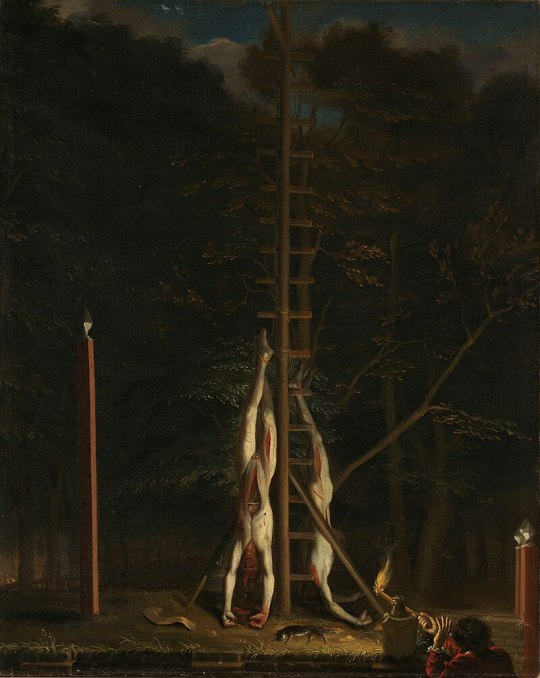
The Corpses of the De Witt Brothers by Jan de Baen. Image via Wikipedia.
With De Witt gone power went to William III of Orange, the same man who had his appointment as captain general stalled by De Witt and the son of William II whose death was used by De Witt and his father to make the turn to the Republican force that they hoped would keep the House of Orange out of power for good.
Whether William III had a hand in planning the attack and death of the De Witt brothers is debated to this day with answers unknown.
Today the prison where the De Witt brothers spent their last moments on earth still stands and has been repurposed as a history and art museum.
**********************************************
Sources:
That Time the Dutch ate their Prime Minister by Vlad Moca-Grama. DutchReview.com, March 3rd 2023. https://dutchreview.com/culture/dutch-history-crowds-ate-prime-minister/
A Dark and Stormy Bite: That Time a Bunch of Dutch People ate Their Prime Minister by Lillian Stone. TheTakeout.com, January 15th 2021. https://thetakeout.com/a-dark-and-stormy-bite-that-time-a-bunch-of-dutch-peop-1846044366
Johan De Witt. Encyclopedia.com.https://www.encyclopedia.com/history/encyclopedias-almanacs-transcripts-and-maps/johan-de-witt
#husheduphistory#featuredarticles#history#forgottenhistory#strangehistory#weirdhistory#tragichistory#historyclass#truestory#truth is stranger than fiction#DutchHistory#NetherlandsHistory#JohanDeWitt#ShockingHistory#horrorhistory#sadstory#HollandHistory
3 notes
·
View notes
Text
Mystic, Murder, and Mystery: The Detroit Tragedy on St. Aubin Street
In the hours between the evening of July 2nd and the morning of July 3rd 1929 Benny Evangelista had several visitors to his home that he shared with his wife and four young children. The first visitor came and went. The second, Vincent Elias, was visiting Benny to discuss a real estate matter and he walked through the house and made his way to the basement, a space that made many people uneasy. The third visitor was the Detroit Police Department. In an instant their day became very complicated and much more difficult, no one was going to want to talk to them about the Evangelista home on the corner of St. Aubin Street.
Benjamino Evangelista was an immigrant to the United States, arriving with his brother Antonio in 1904 after leaving Naples to pursue a better life. Beginning his new chapter in Philadelphia, Benjamino changed his name to Benjamin and probably looked forward to a bright future with his brother, but their relationship crumbled apart two years after arriving in the states. Antonio was a devout Catholic so he became concerned when his brother Benny began telling him that he was receiving visions from beyond, something that was completely unacceptable in his eyes. The two brothers that traversed the Atlantic together parted ways and Antonio sent Benny away to work for a railroad construction crew in York, Pennsylvania.

Benny Evangelista. Image via the-line-up.com.
Whatever camaraderie Benny missed from his brother he may have found again in one of his new co-workers. Aurelius Angelino became very close with Benny, and unlike Antonio, Aurelius never thought ill of Benny’s growing interest in the occult and his visions, mostly because he was also heavily interested in some darker mystical practices. But, this connection would also come to an end, and in a much more brutal way than the parting between Benny and Antonio. In 1919 Aurelius snapped, attacking his family with an ax and killing his twin sons in the process. He was captured and sent to live out the rest of his days in the Fairview State Hospital for the Criminally Insane, but Benny was deeply disturbed by what happened and in order to put distance between himself and the ax murderer he moved to Detroit, Michigan looking for his 3rd fresh start in fifteen years.
After moving to Michigan it would seem that Benny finally found the prosperity and peace he was looking for. He found work as a carpenter, found a second source of income in real estate, he married a woman named Santina and began his new family. Feeling comfortable in this new chapter he also revived an old interest, his practice in the occult. This time though, it was no secret part of Benny’s life, he became very open about his beliefs and soon began selling his services to the people of Detroit.
Word of Benny Evangelista spread quickly through the city, a mystical healer who saw visions, spoke to God himself, and who could create hexes, potions, and whatever else one might need to make it through the tough city days where life was difficult and full of both human and non-human obstacles. After moving the family to their home on the corner of St. Aubin Street he converted the basement of the house to a an almost makeshift “worship space”, filled with tables, alters, bottles, ingredients, knives, and jars among other paraphernalia. The space though, was not a pleasant one. It was said that Evangelista conducted much darker business in his lair including animal sacrifices, intense chanting, and creating bizarre depictions of gods handcrafted by the “healer” himself. Also stacked around the space were copies of the book he wrote, The Oldest History of the World Discovered by Occult Science in Detroit, Michigan, the first in a planned four volume series documenting what Benny said was told to him straight from God. Walking past the house it was possible to see into the basement and if it was the right angle someone might be able to catch a glimpse of the "Great Celestial Planet Exhibition”, a large collection of human figures and planets made from paper mâché, wax, wire, and wood that were hung from the basement ceiling surrounding a handmade “eye” that could light up. One did not have to hope for a peek at the basement though, for the price of five whole cents Benny would take anyone down for a tour of his ritual space.

Some of the wax figures hanging in the basement of the Evangelista home. Image via the-line-up.com.
Tours of the basement were one thing, but Benny had other ways to make his practices profitable. People went to him to solve all the problems they could not through his mystical means, charging up to ten dollars for his services, an amount of money that could equate to days working in some of the local factories. Benny was not cheap, but he also was not overly successful and many of those who sought out his services later complained that nothing was cured, nothing was solved, and he was just a scam artist. That is, if anyone from the predominantly Italian Catholic community was even willing to admit they spoke to the self-proclaimed healer.
On July 3rd that hesitancy to talk was going to become much, much stronger. Vincent Elias walked into the Evangelista home with real estate on his mind but once inside he noticed something else, the house was quiet. Benny shared the home with his wife and four small children between eighteen months and seven years old, the last thing that should have greeted Vincent was silence. He walked down to the basement, and it was there that he found Benny, seated at his desk, his hands folded in prayer, and his head removed and sitting on the floor at his feet. Also under the desk were three photos of a child in a coffin, one of Benny and Santina’s children who died years earlier. And what of Santina? When police arrived at the Evangelista home they found the worst case scenario. Santina was dead, nearly decapitated and partially dismembered, and all four of the Evangelista children were deceased.
The news of the absolutely horrific murders dominated headlines in the coming days and the big question was “Who?” Yes, Evangelista was beyond eccentric and had crossed many paths with his work as a carpenter, his real estate dealings, and as a “healing mystic” but could anyone be so dissatisfied with Benny that they would brutally and ruthlessly murder him and his entire family? Neighbors and clients gathered around the house to learn about the horrors inside but no one in the heavily Italian and Sicilian neighborhood would speak to the police. Authorities were unable to get a single statement from any of Benny’s clients or neighbors. All they had on that morning was the terrible scene inside the house and a single bloody fingerprint on the doorknob.

One of the headlines about the Evangelista murders. Image via newspaper.com.
Very slowly pieces started to fill in the puzzle, but the picture was not made any clearer. When police spoke to Benny’s doctor it only confirmed what was already known, that he was a religious fanatic. Benny’s lawyer told police he was recently involved in several lawsuits stemming from his real estate business but they were all very minor cases, nothing that would warrant murder. Without an obvious suspect they began to look outward. In searching the house police did find a six-month old letter that simply stated “This is your last chance.” With this letter came a new theory, perhaps the Evangelista family were all victims of the criminal group known as the “Black Hand” that regularly preyed on Italian immigrants. The gruesome and extreme killings fit the bill for an organized crime hit but the problem was that by the time this letter would have been sent the Black Hand had already moved on to bigger people and ploys, not even operating under that name, and highly unlikely to target a man and his family for some sort of singular, low-level disagreement.
There were two clients of Benny’s that the police did become curious about. On the night before the bodies were found a man named Umberto Tecchio visited Evangelista at his home in order to make a final payment on a house that Benny sold him. He visited the home accompanied by his friend Angelo Depoli and after leaving the Evangelista home both men went out for some drinks. The police brought Umberto in for questioning based on the fact that an ax, a knife, and freshly-cleaned boots were found behind a barn at the boarding house where he lived. There was also the fact that Umberto stabbed his brother-in-law to death three months earlier. But, with no real evidence and no confession Umberto was let go. The second client was of interest not because he was at the scene hours before the bloodbath was discovered, but because they were never there at all. The night before the killings Benny spoke to a watchman that was looking over a house that was about to be torn down. Being a carpenter, Benny told the watchman he had arranged to purchase the lumber and scheduled a truck to help him take it. He would meet the truck at the abandoned house with a cash payment and the lumber would be delivered to his home. It is obvious why Benny never arrived the next morning, but the crew hired to haul the lumber also never showed up. Again, nothing could directly tie the two occurrences together and the theory was dropped.
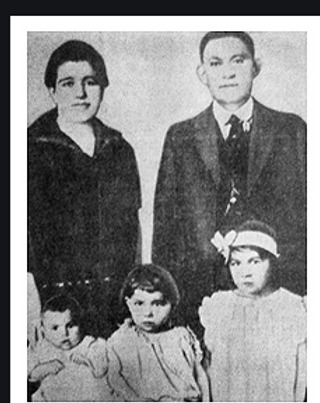
Benny, Santina, and three of their children. Image via hankslore.com.
There was one other possibility that also could not be proven, but even the thought of it proved to be chilling. The reason Benny Evangelista ended up in Detroit was because his close friend and fellow student of the occult Aurelius Angelino murdered his children with an ax and was sentenced to Fairview State Hospital for the Criminally Insane. In 1923, six years before the slaughter of the Evangelista family, Angelino escaped the hospital and was never seen again. Is it possible that over the course of six years Angelino was able to track down his former friend multiple states away and then brutally murder him and his family just like he had done to his own before once again slipping away and disappearing into the darkness? If it was Angelino, the Evangelista family may not have been his only targets. Two weeks prior to their killing another brutal murder took place just under nine miles from Detroit in River Rouge, Michigan where the bodies of Mrs. Henry Cipinski and her three children were also found horribly mutilated.
The funerals for the members of the Evangelista family took place on July 6th 1929 and over three thousand people attended. Some were clients of Benny, others believed he was a fraud, but everyone was shocked about the end that came to him, his wife, and their four children. Police were on site for the funerals all day to ensure the scene stayed peaceful but also to see if anyone suspicious showed up. No one in attendance caught their attention and the funerals went on uninterrupted.
In March of 1930 a newspaper headline printed a misleading story claiming that a witness to the crime had been found. Although they technically were right, it would not help shed any light on the crime. At some point during the killings, the family dog escaped the house. Nearly a year later a woman found a stray dog and upon reading the tags discovered it once belonged to the Evangelista family. She adopted the dog and newspapers dubbed the pup the “only witness” to the horror.
The two-story home where the Evangelista family lived on the corner of Saint Aubin Street and Mack Avenue was eventually demolished and the site was never rebuilt on, leaving an empty dirt lot to tell the tale of one of Detroit’s most notorious murders.
To this day the case of the Saint Aubin Street Massacre is unsolved.
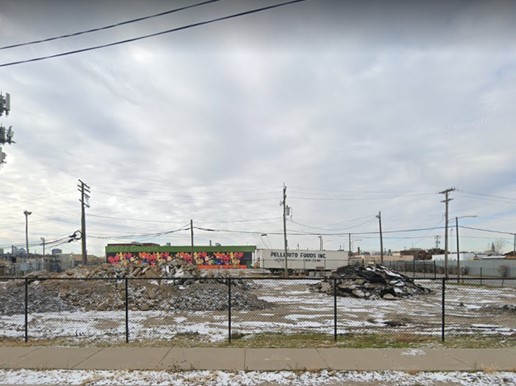
The former site of the Evangelista home today. Image via Google Maps.
****************************************************************
Sources:
The Evangelista Occult Murders One of the Most Sinister Crimes in Detroit History. American Hauntings. https://www.americanhauntingsink.com/evangelista
The Detroit Occult Murders: What Happened to Benny Evangelista? By Lauren Dillon. Historic Mysteries. June 17th 2022. https://www.historicmysteries.com/evangelista-murder/
Unsolved: The Brutal Massacre of the Evangelist Family by Marc Hoover. 2020. https://vocal.media/criminal/unsolved-the-brutal-massacre-of-the-evangelist-family
Detroit Free Press, July 4, 1929, Page 1. via Newspapers.com (https://www.newspapers.com/article/detroit-free-press-st-aubin-street-massa/116854832/ : accessed September 10, 2023), clip page for St Aubin Street Massacre by user holleymh
St. Aubin Street Massacre: The Benny Evangelist Family Murders by Elizabeth Tilstra. The Lineup. January 18th 2016. https://the-line-up.com/benny-evangelist-murders
#husheduphistory#featuredarticles#Detroit#DetroitHistory#Michigan#MichiganHistory#truecrime#forgotten history#strangehistory#tragichistory#tragictale#forgottenhistory#truth is stranger than fiction#truestory#sadhistory#horrorhistory#scaryhistory#realhorror#history#historyclass#unsolved#unsolvedmysteries#unsolved crime
0 notes
Text
Strange in Chains: Two Prisoners with Stories that go much Deeper that the Surface
The Pakistani town of Charsadda has witnessed first-hand how quickly war and time can transform a place. Originally called Dheri, the town is said to have been originally settled by Pashtun tribes from Afghanistan who were fleeing persecution. The location of Dheri attracted a great deal of attention and over time it became heavily populated by the Sikhs who established a monopoly of businesses there. In the 1830s aggressive hands brought a time of change to the town and its inhabitants. Some endured the shifts, some succumbed, and in one case there are some responsible entities that are still standing outside in their chains nearly two centuries later.
In 1835 the town of Dheri’s name was changed to Sikho Dheri and in the same year Maharaja Ranjit Singh laid the foundation to Fort Shankar Gah, which would also undergo a name change in 1876 and then become known as Shabqadar. The Maharajah built a formidable Sikh army, trained by European generals with experience in major battles like the Battle of Waterloo, and they helped keep an eye on some of the many factions that were looking to take power in the region surrounding Shabqadar. By 1840 the Maharaja had passed away but his son Maharaja Sher Singh was in power, and he was there when the fort was attacked by a large number of Mohmand warriors. It was a bloody battle that lasted until the morning sun rose, and in the end the Sikhs were victorious in pushing the opposing forces out of the fort. They may have come out the victors, but it came with a high human cost. Infuriated, Maharajah Sardar Sher Singh demanded to know who was responsible for the warriors getting into the fort and he demanded an investigation be carried out to determine who was behind the breech in security.
One of the Europeans that trained the Sikh army as part of Maharaja Ranjit Singh’s court was General Ventura Jean Baptiste, and he just happened to be in the area. After being recruited to conduct the investigation as to how the warriors were able to gain access inside the fort General Baptiste poured over the incident gathering evidence and examining the facts. Finally, after two days, he had his culprit.
When General Baptiste announced his verdict it was shocking, but the accused had nothing to say. He formally declared that the doors, the twelve-foot tall wooden doors to the fort, the doors that failed to hold back the invasion, were the guilty party. A jury of two men agreed and the two doors were sentenced to be imprisoned by chains for one hundred years.
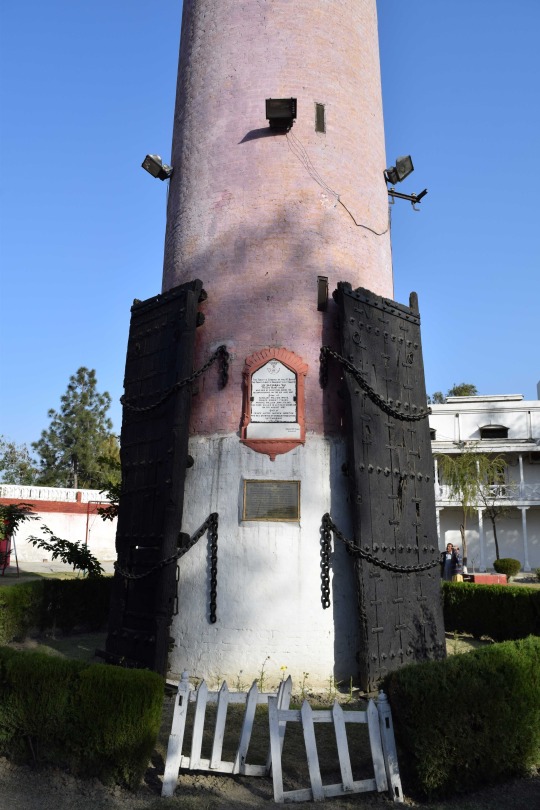
The fort doors under arrest at Shabqadar. Image via travelpangs.com.
It is unknown exactly why the blame was officially placed on the doors as opposed to any of the people involved in the altercation. Each door was chained to a tower, and although their sentence ended in 1940, they still remain there to this day. A plaque tells visitors of their alleged crime and sentence, reading:
“The weeping willows: In the winter of 1840, a Mohmand Lashkar (War party) succeeded in breaking down these gates. The then Sikh Maharaja Sher Singh (Ranjit Singh son) had them court martialed for treason. The French General Jean Ventura headed the proceedings which lasted two days, having found them guilty as charged, the gates were sentenced to 100 years’ imprisonment. They are languishing enchained ever since.”
Approximately two hours west of Shabqadar is another unfortunate prisoner. In 1898 a British Army officer named James Squid was stumbling through the town of Landi Kotal after having a few too many drinks and he saw a threatening figure, a Banyan tree. Convinced that the tree was moving, and even following him, he ordered the mess sergeant to place the tree under arrest. The sergeant obliged, placing the tree in multiple heavy chains extending from the branches to the ground.
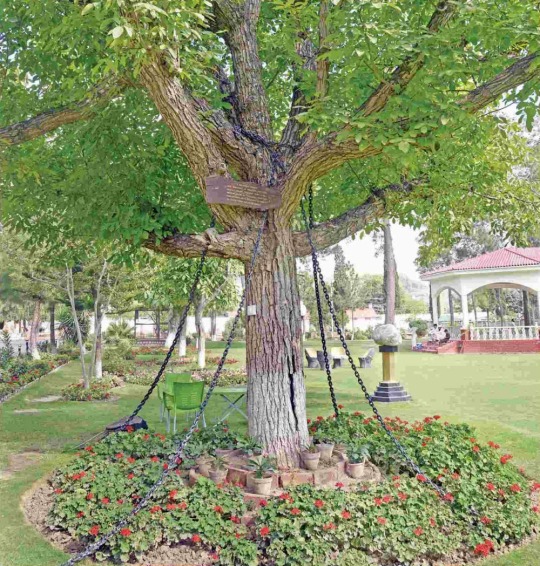
The Banyan tree under arrest. Image via amusingplanet.com.
Visitors today can still visit the tree, which tells its story through a sign that plainly states:
“I am under arrest. One evening a British officer heavily drunk thought that I was moving from my original location and ordered mess sergeant to arrest me since then I am under arrest.”
Though originating as what some might see as a humorous story, the tree is seen by many as a solemn reminder of the chapters of Pakistan’s past that are deeply intertwined with the British. Pakistan gained their independence from England in 1947 but when the Banyan tree was arrested it was in the midst of British colonialism. Today the image of the tree in chains represents that oppressiveness and how the people of Pakistan were treated during that time and represents the Frontier Crimes Regulation (FCR), laws drafted specifically in opposition to British Raj and their rule. As expressed by a local photojournalist, the tree “shows the oppression of British rule in the subcontinent and just imagine if a British officer could put a tree in chains then how were they treating the locals of that era?"
Today both Shabqadar and the Banyan tree are visited by thousands of people each year as tourist attractions but their stories go far deeper than just inanimate objects officially placed under arrest. The failed fort doors and the innocent tree tell stories of both individual incidents and whole timeframes that are written deeply into the complex and rich history of Pakistan and how it is still imprinted on the country today.
************************************
Sources:
The Weeping Willows of Shabqadar, Pakistan. Travelpangs.com. August 10 2020. https://www.travelpangs.com/post/the-weeping-willows-of-shabqadar
The Doors that won't Open by Syed Rizwan Mahboob. September 13 2015. https://www.thenews.com.pk/tns/detail/559381-doors-sentenced-100-years-shabqadar-fort
The Doors of Shabqadar Fort by Sadaf Shahzad. June 24 2021. https://www.youlinmagazine.com/article/the-doors-of-shabqadar-fort/MjAyOA
Colonial rustlings: Under the shade of the chained banyan tree. Published in The Express Tribune, January 6th, 2013. https://tribune.com.pk/story/489734/colonial-rustlings-under-the-shade-of-the-chained-banyan-tree/
This chained, century-old tree in Pakistan is a perfect metaphor for colonialism by Ishaan Tharoor. September 3 2016.https://www.washingtonpost.com/news/worldviews/wp/2016/09/03/this-chained-century-old-tree-in-pakistan-is-a-perfect-metaphor-for-colonialism/
The Tree That Was Arrested by Kaushik Patowary. September 6 2016. https://www.amusingplanet.com/2016/09/the-tree-that-was-arrested.html
Tree in Pakistan remains ‘under arrest’ for 120 years by By Islamuddin Sajid. February 5 2018. https://www.aa.com.tr/en/asia-pacific/tree-in-pakistan-remains-under-arrest-for-120-years/1132523
#husheduphistory#featuredarticles#truestory#historyclass#truth is stranger than fiction#pakistan#PakistanHistory#LegalHistory#oddlandmarks#strange history#oddhistory#quiethistory#lesserknownhistory#more than meets the eye
2 notes
·
View notes
Text
Dealt a Hand of Death: The Terrible Table of the Delta Saloon
When gold was discovered in California on January 24th 1848 it changed the landscape of the country with approximately 300,000 people swarming to the state from all over dreaming of striking it rich and finding fortune in the ground. Undoubtedly, the California Gold Rush was familiar to Henry T. “Pancake” Comstock, a Canadian miner and acquaintance with brothers Ethan Allen and Hoesa Ballou Grosh. The Grosh brothers were veterans of the California gold fields and in the fall of 1857 they discovered a promising ore deposit in Virginia City, Nevada. But, before they could claim the land both brothers tragically died. Hearing of their deaths, Comstock took it upon himself to take over their cabin, open their belongings, find the documentation connected to their find, and essentially claim it as his own. In the spring of 1859, two miners named Peter O’Riley and Patrick McLaughlin began to work the area around Six-Mile Canyon when they made a huge discovery, a deposit of silver ore, but their elation was short lived. Comstock claimed the men were working on land he had already claimed for “grazing purposes” and he proceeded to threaten them to the point that in order to avoid issues the miners made him a partial owner in the claim, later named the Comstock Lode.
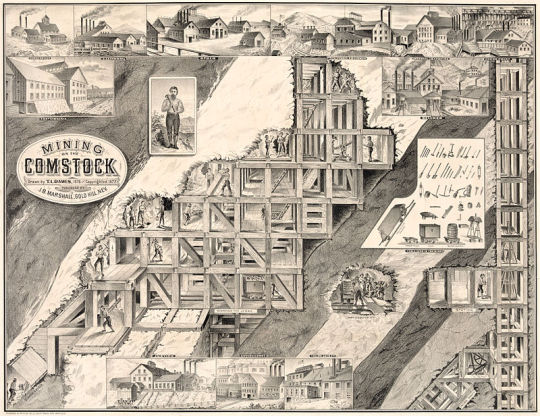
Mining on the Comstock. Image via wikipedia.com.
The men had no idea what they had discovered. The Comstock Lode was a massive deposit of silver ore, the first of its kind in the United States, and news about new riches found under the earth brought back the excitement of the California Gold Rush from less than ten years earlier. From its discovery in 1859 to 1882 the Comstock Lode yielded what would today amount to over ten billion dollars worth of ore. However, none of the men who discovered the claim never saw that level of wealth. Patrick McLaughlin sold his 1/6 interest in the claim for $3,000 but the money was quickly lost and he died after working multiple odd jobs to scrape by. Peter O'Riley held on to his interests at first but eventually sold them for approximately $40,000. He used the money to invest in other endeavors including a hotel and another venture into mining but his attempts were unsuccessful. He lost everything, was declared insane, and his life came to a close in a California asylum.
Henry Comstock sold his interests and went on to open various shops in Carson City and Silver City. He too lost everything in bad business decisions and in September 1870 he died in Montana after shooting himself in the head.
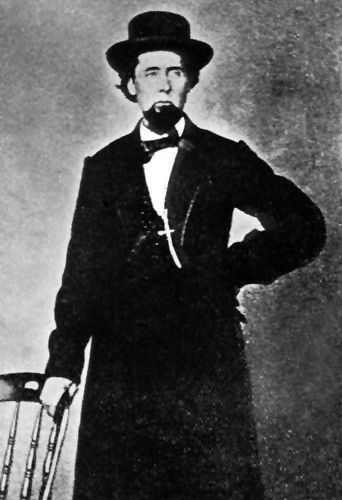
Henry T. "Pancake" Comstock. Image via legendsofamerica.com.
When the Comstock Lode was discovered it completely transformed Virginia City, Nevada. Once a small mining town it was quickly filled with hundreds of thousands of prospectors, driven by the re-ignited dreams of fortune just waiting to be dug up. The influx of people brought everyone imaginable to Virginia City, and it quickly transformed into a place where law dared not tread. Filled to the brim with bordellos, saloons, and opium dens, the city became the darkest definition of the wild west. In 1872 Mark Twain published his semi-autobiographical novel Roughing It where he wrote about his travels by stagecoach through the American West and later the islands of the Pacific. In the book he writes about his trip to Virginia City stating that “Two days before I lectured in Virginia City, two stagecoaches were robbed within two miles of the town.” Twain himself was later robbed at gunpoint once he arrived in the city, losing his money and a gold watch.
Dreams, greed, and human beings all swept through the west and Virginia City, but there was one more thing that was keeping all of their minds occupied, a card game called Faro. Played using one deck of cards and being fairly easy to learn, gamblers quickly made Faro the dominant card game of every gambling hall in the west from 1825 to approximately 1915. One man who was well versed in the game was a Virginia City gambler named “Black Jake” who decided he was going to capitalize on its popularity, buy himself a Faro game table, and make himself rich taking cash out of every pocket he could. He was known for being a greedy man, but one night in 1861 karma came back strong and the table turned on its owner with Black Jake losing multiple rounds and $70,000 in one night. With absolutely no way to pay out that amount of money, the equivalent of two million dollars today, the disgraced gambler grabbed his pistol and took his own life at the table. With Black Jake gone the table needed a new home, and a few years later it found a new owner whose name has been lost to time. This new owner operated the table for exactly one night where he too lost everything, including his life. It is unknown if he chose to take it himself, or if it was taken from him.

Playing Faro in a saloon circa 1895. Image via wikipedia.com.
Having claimed two lives, the table was stored in the back room of where it was last used, The Delta Saloon, where it would sit undisturbed for decades. It wasn’t until the late 1890s that wealthy businessman Charles Fosgard laid eyes on the table, and he was happy to buy it. Fosgard had a lot of money, but he was looking to reinvest it and in Virginia City with its thrill-seeking gamblers looking to strike it rich in the saloons when they couldn’t in the mines, it made perfect sense to Fosgard to bring the notorious table out of retirement. After converting it into a blackjack table, Fosgard went into business.
One night a drunk miner sauntered into The Delta Saloon and made his way to the blackjack table. To Fosgard’s delight the miner lost hand after hand until he only had one thing left to offer the businessman, his gold ring. He bet the ring against a five dollar coin and finally, he won a hand. Then he won another….and then he won another. The miner and Fosgard went face to face over and over again and a crowd grew to watch as the businessman was forced to hand over everything. By the end of the game the miner was the new owner of Fosgard’s stagecoach, his share in a local gold mine, and $85,000 (over 2.5 million dollars in today’s money.) Fosgard’s fortune was decimated and he did the only thing he could think of, he pulled out his gun and took his life at the same table as the previous two owners (and in the same way as not only them, but also the less-than-legit founder of the Comstock Lode that brought them all there.)
The table was soaked in enough tragedy and it was put out of commission with a new dubious nickname of The Suicide Table. Year after year, and as the population of Virginia City depleted, the story of the table only grew and it was eventually made a feature of The Delta Saloon. People came from all over to see the table, guided by a sign that cheerfully read “See the Suicide Table” in bright paint as you approach the building that had been restored as faithfully as possible to how it was in its heyday in the 1800s. The table itself was also restored, brought back to its original state as a Faro table. It stayed a Delta Saloon attraction for decades, saw in new centuries, and lived quietly with its tragic past and infamy.

Vintage postcard showing The Suicide Table on display at The Delta Saloon. Image via ebay.com.
Then, on March 11th 2019, Virginia City was shaken when a gas explosion occurred at The Delta Saloon. Amid the damage sat The Suicide Table, unscathed other than receiving a coating of dust. Movers were brought in and the table was relocated to the Delta’s sister saloon, The Bonanza Saloon, right across the street where it remains on display under protective plastic housing.
The Suicide Table is still a major attraction in Virginia City, attracting the gaze of thousands of people lured in by its horrific past. In a time and place that encompassed the lawless American West like Virginia City, there are many shocking tales to tell. But standing out in the crowd is a simple Faro table, created as a game of chance, and tied to at least four lives suddenly lost in the bloody name of greed.
*****************************************************
Sources:
Step Back in Time Virginia City Nevada by The Virginia City Tourist Commission. 2022. https://visitvirginiacitynv.com/history/
Comstock Lode – Creating Nevada History by Legends of America. 2023. https://www.legendsofamerica.com/nv-comstocklode/
The History and Nostalgia of The Delta Saloon by The Delta Saloon. 2023.
The Old West Card Table With a Deadly Past by Danielle Hyman & Adam Aronson. The Daily Beast. September 3, 2018. https://www.thedailybeast.com/the-old-west-card-table-with-a-deadly-past
Men’s luck ran out at gaming table by Dave Maxwell. Boulder City Review. June 17, 2020. https://bouldercityreview.com/community/mens-luck-ran-out-at-gaming-table-61432/
#husheduphistory#featuredarticles#truestory#forgottenhistory#strangehistory#weirdhistory#tragichistory#history#historyclass#NevadaHistory#mininghistory#goldrush#AmericanWest#WildWest#cursedobjects#gaminghistory#comstocklode#cardgame#VirginiaCityHistory#DeltaSaloon
3 notes
·
View notes
Text
A Last Ride on the Rails: The London Burial Crisis and the Train to Eternity
London had a problem on its hands. By the mid 19th century the city already had an extremely long and storied history but with the turn of the century came the masses. The lure of the city, with its industry, its jobs, and its connections to the rest of the world caused the population of London to double by 1850. The streets and structures were packed with humanity and all the debris, pollution, and chaos that came with it. And while these were all major problems facing the city, time was running short on finding a solution to one of the biggest issues. The problem was not brought on by the living, one of the most urgent matters was being caused by London’s dead.
Previous to the mid-19th century the typical way to dispose of the dead was to bury them in one of the many small church graveyards in family plots or an unmarked place of eternal rest. With the massive influx of people filling the London streets it also meant a level of death unseen by a city that was poorly equipped to deal with the bodies stacking up. The living population doubled, but the land set aside for the dead remained at only approximately 300 acres scattered throughout 200 small burial sites.
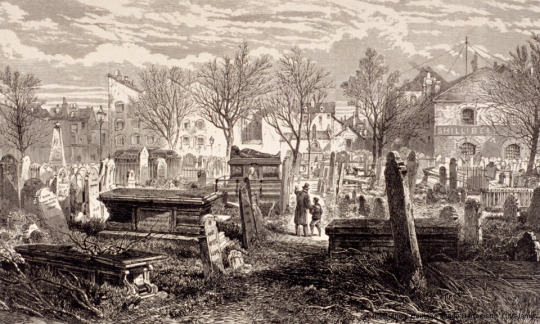
Illustration Cemetery at Bunhill Fields, Finsbury, London, 1866. Image via nhm.ac.uk/discover/a-history-of-burial-in-london.html.
Graves were dug hastily, just for the bodies to reappear above ground after a heavy rain. Plots were dug only for the shovels to hit unexpected layers of bones. Old bodies were dug up and discarded to make room for the fresh corpses. The London burial crisis was in desperate need of a solution and in 1830 Parliament thought they had it with the creation of the “Magnificent Seven,” seven massive, privately run burial grounds that lay just outside the borders of the city. They were sprawling, picturesque, beautifully maintained….and woefully expensive. The only problem that the Magnificent Seven solved was how to die if you had deep pockets. The vicious cycle continued. The dead infected the living, plagues and epidemics swept through the streets taking more souls and adding to the piles of bodies that only further infected those who survived the last miasma. In 1842 a Royal Commission was established to investigate the crisis and the findings were grim. It was determined that London simply had no more graves to give, there was no room, and digging a new grave would inevitably unearth a current tenant. There would have to be a solution, but things became much worse when a wave of cholera swept through the city in 1848, lasting a year, taking over 14,000 lives, and completely decimating any thin sense of optimism someone may have had of finding a quick and efficient answer for disposing of the dead. The already overwhelmed city soon became crushed over the influx of bodies and the accompanying decay and disease. By 1851 the epidemic had slowed and the Act to Amend the Laws Concerning the Burial of the Dead in the Metropolis, also known as the Burials Act, was passed forbidding any further burials to take place in the most heavily populated areas of London. There was simply no other option, the burial grounds that did exist were not good at hiding the overcrowding problem from the world and the ground was actually growing taller due to the sheer amount of humans in various stages of decay that were packed inside. According to an 1852 account David Bartlett remarked:
“Many times in our walks about London we have noticed the grave-yards attached to the various churches, for in almost every case, they are elevated considerably above the level of the sidewalk, and in some instances, five or six feet above it. The reason was clear enough—it was an accumulation for years of human dust, and that too in the centre of the largest city in the world.”
Even Charles Dickens commented on the heights of the growing graveyards, saying that they were “"conveniently and healthfully elevated above the level of the living."
While the halt on new burials within the city put a stop to the rampant unavoidable exhumations in the burial grounds it led to another question. How do we prevent any new cemeteries from becoming just as full down the road? London was going to continue to grow and people were not going to stop dying, a plan needed to be in place.
Sir Richard Broun and Richard Sprye were entrepreneurs who believed the growth of London was partially due to the recent industrialization, and they also believed that industrialization could be an answer to the burial problem by using a new and controversial addition to the city, the railroad. The pair crunched the numbers and presented their plan. A 500-acre tract of land twenty-three miles outside of London in the village of Brookwood would be purchased and the already existing London and South Western Railway would dedicate one train a day to the purpose of transporting the dead to the new Brookwood Cemetery in dedicated coffin trains. The bodies would be kept at the cemetery until families arrived for the funerals by dedicated train, a fast and efficient way to attend that would otherwise require an agonizingly long horse and carriage ride of over ten hours. Broun estimated that the cemetery could hold 5,830,500 individual single-depth graves, enough to last 350 years before the burial ground would be full. Some people were against the railway, feeling it was demeaning to the dead, but on June 30th 1852 the London Necropolis and National Mausoleum Company (LNC) was formed. But, there were numerous roadblocks before things could officially get underway.
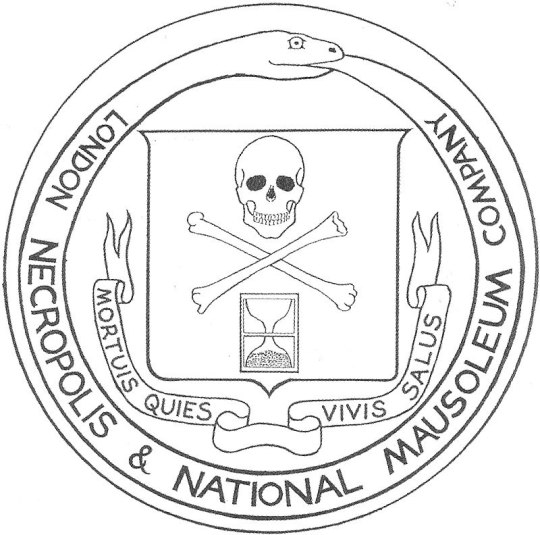
Great Seal of the London Necropolis and National Mausoleum Company. Image via wikipedia.com.
For one, the entire operation had to be built from the very beginning, and there were some very differing ideas as to how the project should proceed. Broun and Sprye knew what they wanted, but consulting engineer William Cubitt denied idea after idea. By September 1853 Broun and Sprye were out of the picture, an entirely new Board of Trustees was in place, and work could finally begin on the railway. A 2,200-acre tract of land stretching to Brookwood was purchased, and a railway line was constructed branching off from the main rail line leading directly into the westernmost section of land where the cemetery would begin. Just over one year later on November 7th 1854 the cemetery opened under the name Brookwood Cemetery with the Bishop of Winchester consecrating the ground dedicated to Anglican burials. At the time it was the largest cemetery in the world and the burials began fast, the first train left the London Necropolis Railway station on November 13th carrying the first to be buried that same day, the stillborn twins of a Mr. and Mrs. Hore.
The opening of Brookwood Cemetery and the London Necropolis Railway made dignified death accessible to all. Boasting the same gardens and grandeur of the luxury cemeteries, people could afford to bury their loved ones without risk of finding graves already occupied, without fear of them unintentionally resurrecting, and knowing they were being laid to rest away from the pollution and hazards of burials in London before the Burials Act was passed.
The company had a private terminal in London’s Waterloo Station and when a person died their body was transported there to lay in storage underneath the archway until it was time for their burial. The terminal for the Necropolis line was separate from the London and South Western Railway and it housed two mortuaries, the boardroom for the London Necropolis and National Mausoleum Company, and separate waiting rooms for those attending first-, second-, and third-class funerals. On occasion, these waiting rooms could be used as makeshift chapels if there were family members who were unable to make the journey to Brookwood Cemetery. This separate terminal prevented hearses from blocking the street but it also allowed mourners to arrive at the railway in private. Once arrived, the families and friends of the deceased gathered at the train station in the morning and boarded railcars that were separate from the cars dedicated to carrying the dead.

The original Necropolis Railway station in Waterloo. Image via https://www.cultofweird.com/death/london-necropolis-railway/
First-class funerals got the mourners first-class train tickets but also allowed them to select a grave location of their choice and guaranteed them that a permanent memorial would be erected by the London Necropolis and National Mausoleum Company. Second-class mourners had less control over burial location and had to pay an additional fee for a stone. Third-class was reserved for the pauper burials where expenses were paid at the expense of the parish. Because of this, the parish decided where the grave would be located and there was no permanent marker. It may seem like all the control was given away, but here in Brookwood Cemetery even the paupers were promised their own, private resting place rather than being disposed of in a mass grave. Large numbers of graves in the overcrowded London burial grounds were even dug up and the bodies moved to Brookwood, finally giving them their own place of rest.

Third class ticket to Brookwood Cemetery. Image via wikipedia.com.
The train cars themselves also had their own class structure and people were separated into either Anglican or Noncomformist in first-, second-, or third-class seating which were all very similar with the exception of some differing decorative elements. Once inside the cemetery itself there were two different stations, North Station for the Nonconformists and South Station for those belonging to the Church of England. Each station were single-story structures made primarily out of wood and they served as much more than just a station stop. The buildings were the funeral reception areas, it was where cemetery staff lived inside built-in apartments, it was where upper class mourners could select pre-made headstones, and it’s also where the “refreshment rooms” were. Each station was fully licensed to serve alcohol during normal business hours, and they catered to more than just the mourner. A relative of a member of the cemetery staff once recalled: “In addition to catering for mourners, who mostly came down from London by train, we also had local people who walked through the cemetery calling in for afternoon tea…” The refreshment rooms were also where the train crew stayed while the funeral was going on and on at least one occasion in January 1867 the driver of the train became too drunk to drive back, leaving a fireman to drive the train back to London.

North Station of the Brookwood Cemetery. Image via wikipedia.com.
By 1896 congestion had become an issue and the London and South Western Railway proposed that they would provide the Necropolis Railway with a new station in exchange for their old terminal. An agreement was signed in May 1899 and on February 8th 1902 the new Necropolis Railway terminal opened. The new four-story building held the company offices, mortuaries, storerooms, waiting rooms, ticket offices, and a dedicated chapel space for those unable to travel to the cemetery. Portions of the London and South Western Railway were then widened to accommodate the growing Waterloo station and the original site of the Necropolis Railway was destroyed in the construction.
Although the London Necropolis and National Mausoleum Company solved a massive problem for the dead of the city, the long-standing phenomenon envisioned by Broun and Sprye came to an end sooner than they anticipated. When Broun and Sprye proposed their revolutionary burial solution the numbers they presented were staggering, an ability to bury millions of bodies and have burial spaces available for the next 350 years. But, in the first twenty years of operation Brookwood Cemetery had only seen approximately 3,200 burials a year. The first indication of the decline came in October 1900 when the railway eliminated Sunday services, but the real death blow came just over forty years later.
On the night of April 16th 1941 London experienced one of the worst nights of the London Blitz with bombs raining down on the city, starting thousands of fires and taking 1,000 lives by the time it ceased. The terminal for the Necropolis Railway was destroyed with only the platforms, first class waiting rooms, and offices surviving. The train itself was described as “burnt out” and the station was immediately closed down with decisions about the future of the railway to be figured out after the war. When the time came to revisit the train line in 1945 there were major obstacles standing in the way of any hopes to reopen. The cost of rebuilding the station, the trains, and fixing the now-neglected tracks was going to be substantial and the fact that use of the line was beginning to decline even before the war made repair and reopening seem unnecessary. The Necropolis Railway was officially, and unexpectedly, permanently closed.

The London Necropolis Railway after the bombing of the London Blitz. Image via wikipedia.com
The London and Southwest Railway (which became the Southern Railway after 1923), and the London Necropolis and National Mausoleum Company began negotiations to determine what to do with the facilities. In December 1946 it was decided that the waiting rooms, caretaker areas, and the platforms themselves would be owned by Southern Railway while the office and other remaining portions would continue to be owned by the London Necropolis and National Mausoleum Company to either use or dispose of. They sold the site to the British Humane Association in May 1947 and the offices were relocated to Brookwood Cemetery.
As time went on the railway, and the practice of transporting the dead by rail, faded into obscurity. Portions of the property where the 1902 terminal was located was built over for new offices, the North and South Stations became North Bar and South Bar serving refreshments until they also closed, and the rails to the line into the cemetery were removed in 1947 leaving the former track bed to become a dirt path and eventually a walkway. Today there are still some remnants of the London Necropolis Railway peeking through to the modern day. In London the second building that served as the London Necropolis and National Mausoleum Company offices and the entrance to the first-class terminal on Westminster Bridge Road is still standing as well as some iron columns that once supported the tracks in Newnham Terrace. The North Station inside the cemetery was demolished in the early 1960s because of dry rot and South Station was closed in 1967 and used as a mortuary and storage building for five years. In September 1972 a fire broke out in South Station totally destroying the building leading to its demise by bulldozer that same year. All that remains of the two stations now are their platforms. One building that is still alive and utilized is the chapel that once belonged to South Station, now restored by the St. Edward Brotherhood who use the chapel and maintain a shrine there for the bones of St. Edward the Martyr.
In 2007 a piece of rail track laid out on the former track bed and a plaque were dedicated as a memorial to the railway and the tens of thousands of souls who found their final place of rest after taking a ride on a train.
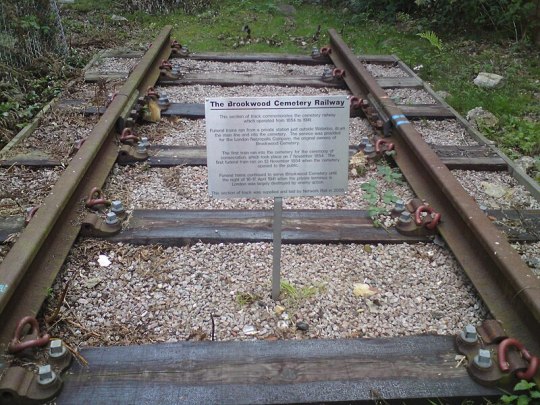
···
The memorial placed for the railway in 2007. Image via wikipedia.com.
****************************************************
Sources
This abandoned railway was London's train for the dead by Katie Thornton. November 2nd 2020. https://www.nationalgeographic.co.uk/history-and-civilisation/2020/11/this-abandoned-railroad-was-londons-train-for-the-dead
Last train home: The Necropolis Railway by Paul Slade. 2013. http://www.planetslade.com/necropolis-railway.html.
The London Necropolis Railway Funeral Train Carried the Dead to their Graves for 87 Years by Charlie Hintz. https://www.cultofweird.com/death/london-necropolis-railway/
A history of burial in London by Hayley Dunning. https://www.nhm.ac.uk/discover/a-history-of-burial-in-london.html
London Necropolis Railway. https://en.wikipedia.org/wiki/London_Necropolis_Railway#London_burial_crisis
#husheduphistory#featuredarticles#BritishHistory#Railroadhistory#CemeteryHistory#Historiccemetery#Historiccemeteries#LondonHistory#LondonBurialCrisis#weirdhistory#forgottenhistory#strangehistory#tragichistory#sadhistory#cemeteries#historyclass#NecropolisRailway#TrainHistory#HistoricRailroad#truestory#truth is stranger than fiction
1 note
·
View note
Text
Light and Dark: The Tragic Times of the Big Bay Point Lighthouse
The waters of Lake Superior have a notorious history with those who have tried to interact with it. Responsible for over 500 shipwrecks and allegedly taking the lives of nearly 10,000 people, it has earned the nickname “Graveyard of the Great Lakes” through the most accurate and unfortunate means. Rising up over these infamous waters on the edge of a rocky cliff is the sixty-four foot tall Big Bay Point Lighthouse, a structure that seems cheery despite the unfortunate tales churning under the surface of the lake below it. This lighthouse has seen many things during its 127-year history but the water is not the only place that has seen its share of tragedy.

Map showing the number of shipwrecks in Lake Superior and calling it the Graveyard of the Great Lakes. Image via https://lakesuperiorstore.com/ShipwreckMaps
The lighthouse at Big Bay Point opened on October 20th 1896 with its white light blazing 150 feet above the water every twenty seconds to warn ships traveling nearby. The lighthouse keeper was provided with a two-story brick structure on site that could house him and his family on one side of the building and his assistant and his family on the other side. On the thirty-three acres of land there was also two cisterns, an oil house, a garage, two brick outhouses, a dock, a well house, and a brick fog signal building all situated outside a forest. It takes a certain kind of person to live the life of a lighthouse keeper, and they sometimes have very strict requirements for their crew.
The first lighthouse keeper of Big Bay Point was H. (Harry) William Prior (sometimes written as Pryor). William was the eldest of three brothers who all had experience tending to lighthouses, but it was William who became notorious for his impossibly high standards and a temper that matched his gruff red hair. William was the ruler of his domain and his extremely detailed logbooks paint the picture of a belligerent man who felt his crew was lazy and untrustworthy no matter what they did. On November 11th 1897 William left the lighthouse in order to attend the funeral of his only sister, a six-mile journey that he did on foot. When he arrived back on November 18th 1897 and saw how his assistant Ralph Heater ran the lighthouse in his absence he made his extreme disappointment known. In his logbook he wrote:
“I can not [sic] see that the assistant has done any work around the station since I left. He has not the energy to carry him down the hill and if I speak to him about it he makes no answer but goes on just as if he did not hear me; he is so much under the control of his wife he has not the hart [sic] to do anything. She has annoyed me during the season by hanging around him and hindering him from working, and she is altogether a person totally unfit to be in a place like this as she is discontented and jealous and has succeeded in making life miserable for everyone at this station.”
The sheer disdain for Heater and his wife became a theme in the logbooks. On January 1st 1898 Prior wrote about how Heater “claimed” he hurt his back, but any thought that Prior might be concerned for his coworker is quickly dispelled by the entries in February where he writes: “Mr. Heater arrived from Marquette at 6 p.m. and walked the entire distance of 33 miles in 12 hours, including two rest stops over an hour each … pretty good gait for a lame man.” This was followed by an entry on February 27th reading “Mr. Heater came across the ice to the other side of Big Bay with his wife. It is Sunday and his back is not lame today.”
Perhaps it was best for both men that Heater ended up leaving the lighthouse and his role was taken on by George Beamer, but soon after his new post began he left to serve in the Spanish American War. Upon his departure he left his wife Jennie to take his place at the lighthouse making her the only woman to ever serve at the Big Bay Point Lighthouse. Once returned though, Prior and Beamer were constantly fighting, Beamer kept insisting he could not work because he hurt his back, and by October Prior was writing:
“Asst. Beamer complains of being sick and talks of leaving the station to go home to Detroit. He is too high strung for a light keeper’s asst, between himself and his wife this season I imagine that I am keeping a Home for the Helpless Poor instead of a U.S. Lighthouse. I and my family having to do the greater part of the work while they receive the pay.”
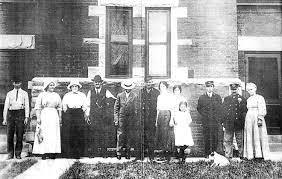
Michigan Lighthouse Keeper crew and families. Image via mynorth.com.
On November 1st 1898 Prior dismissed Beamer, his last written thoughts on him being “this Beamer…is without exception the most ungrateful and the meanest man I have ever met.” The two problematic assistants were gone, but this meant Prior needed a new assistant and his reputation was making it difficult to find a suitable replacement. Since no outsider seemed to meet his high standards, he decided to look within the lighthouse grounds and he soon made his nineteen-year-old son George his new assistant.
Perhaps the two had an understanding or they simply knew each other well enough to work together, but for over a year George and William tended to the lighthouse side by side. Then, in April of 1901 tragedy struck the Prior family. While working one day George slipped and sliced his leg down to the bone. There are differing accounts if William was there and they sought immediate treatment or if George, fearing his father’s temper, waited until he simply could not wait anymore. The nearest hospital was located in Marquette, Michigan and the thirty-mile journey by boat and then on foot had to be nothing short of agony. Young George was checked into the fifty-bed facility on April 18th and that night William, the ever-meticulous record keeper, noted in his logbook “he will have to remain in hospital for treatment.”
The injury and any delay in treatment would prove to be catastrophic to the young assistant. The wound was too severe to simply stitch up and it became infected. Eventually gangrene set in and quickly took over the tissue in his leg. Treatment and medication stopped working and almost two months later on June 13th George Prior died in the hospital. On that day his father wrote in his logbook, “1:30 p.m. Keeper summoned to Marquette to bury his son who died this morning.”
William Prior had a reputation for being the most difficult, the most demanding, and the hardest of iron fists but everything fell apart on that June morning. The death of his son completely shattered him and he spiraled into a deep state of depression. The work fell to the side and the entries in the logbook became less frequent and shorter until June 27th when the entry simply reads “General work.” That was the last entry written by the lighthouse keeper. On June 28th 1901William Prior disappeared. He was last seen walking into the woods on the grounds of the lighthouse and despite an extensive search he simply could not be found. The following fall his widow and four children piled onto a boat and headed for Marquette never to return to the lighthouse.
The following November 1902 a man named Fred Babcock was walking through the woods around the Big Bay Point Lighthouse when he made the horrible discovery. Hanging from a tree approximately half a mile from the lighthouse was a skeleton with some tufts of red hair still visible. An entry was made into the logbook that day and it read:
“Mr. Fred Babcock came to the station 12:30 pm. While hunting in the woods one and a half mile south of the station this noon he found a skeleton of a man hanging to a tree. We went to the place with him and found that the clothing and everything tally with the former keeper of this station who has been missing for seventeen months.”
Newspapers reported the finding in cold detail, writing about how the rope was tied “around the fleshless neck” and without mentioning the death of George, only reported that “…a few months over a year ago, Mr. Pryor wandered off in a fit of temporary insanity, and was never seen again…”
Unfortunately, another tragedy would be tied to the Big Bay Point Lighthouse almost fifty years after the body of William Prior was found in the woods. In 1941 the lighthouse was automated and like many other lighthouses it became a training location for the United States Army and the National Guard. In the 1950s large guns were installed on the cliff to use during practice shooting over Lake Superior and the soldiers camped out in the surrounding fields and woods. One of the men stationed at Big Bay Point was Korean War veteran and member of the 768th anti-aircraft battalion at Camp McCoy in Wisconsin, 38-year-old Lieutenant Coleman Peterson who was there with his wife Charlotte. Lt. Peterson was known to be a very jealous man and on at least one occasion he and Charlotte had gotten into a fight outside the nearby Lumberjack Tavern because he accused her of flirting with another soldier stationed near the Big Bay Lighthouse.
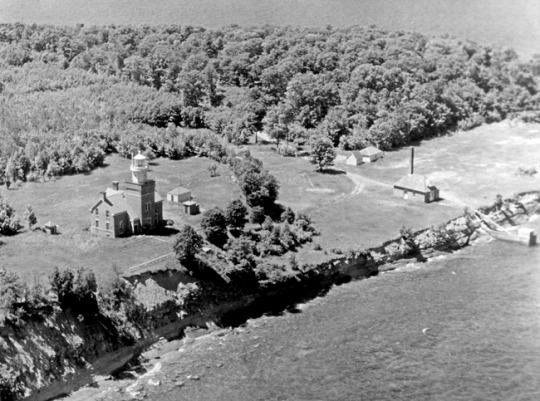
Aerial photo of the Big Bay Point Lighthouse circa 1947. Image via https://www.lighthousefriends.com.
The Lumberjack Tavern was less than five miles from the lighthouse and it was frequented by those stationed there. On the night of July 31st 1952 Charlotte was out drinking at the tavern and she returned back home with a black eye. When her husband confronted her about it, she told him that the owner of the tavern raped her. Peterson left for the tavern and when he arrived just before 12:30 a.m. he walked through the screen door, went straight up to the bar where owner Maurice (Mike) Chenoweth was standing, and shot him six times at point blank range with a 9 mm German Luger automatic pistol. With Chenoweth dead behind the bar he calmly turned around and walked back out into the night as if the entire scene never happened.
Peterson was arrested and when he was brought into court on September 15th 1952 he was represented by John D. Voelker. Voelker used a defense called “irresistible impulse”, stating that Peterson killed Chenoweth due to a bout of temporary insanity. It was a defense that had not been used since 1886 but after only a few hours Peterson was found not guilty by reason of insanity on September 23, 1952. But, as stated in the court, this insanity was only temporary. He was examined days later, declared sane, and released to resume a normal life. Some accounts state that he fled the region, never paying Voelker and soon divorcing Charlotte. No evidence was ever found pointing to Chenoweth being guilty of the crime.
Peterson was free but John D. Voelker was not done with this case. Under the pen name Robert Traver he wrote the book Anatomy of a Murder based on the Peterson murder case. The book was on the bestseller list for sixty-five consecutive weeks and has sold more than four million copies in twenty languages. In 1959 the book was adapted into a film starring Jimmy Stewart. A rare occurrence at the time, parts of the film were shot on location at the Lumberjack Tavern where the original murder took place and in 2012 the film was selected for preservation by the Library of Congress for being "culturally, historically, or aesthetically significant".
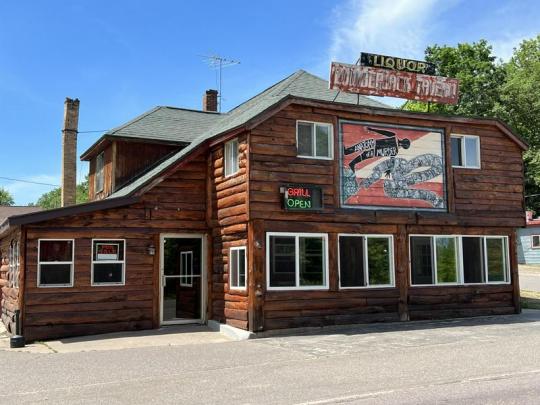
The Lumerjack Tavern with sign advertising Anatomy of a Murder outside. Image via remax.com.
Today, the Lumberjack Tavern is still standing, its walls filled with newspaper clippings and with signs out front proclaiming it as the actual place where the crimes of Anatomy of a Murder unfolded. The Big Bay Point Lighthouse also still stands in the same place where tragedy unfolded in 1901. Today, it operates as a bed and breakfast and its current owners are well aware of its history, partially because there are reports that its past is still very much present at the lighthouse. As told by the current owner to NorthernExpress.com in 2021, “It was haunted when I acquired it…” and there have been reports of footsteps, things moving in other rooms, faucets turning on, lights turning on and off, and some report seeing split-second glimpses of the red-haired William Prior in mirrors, still watching over the lighthouse he lived for and that eventually took the lives of both him and his son.
When the Big Bay Point Lighthouse was officially opened it was meant to be a literal beacon, guiding those away from danger. Its light could not save everyone though, and within its first fifty-two years both William Prior and Lieutenant Coleman Peterson succumbed to “temporary insanity” and became tied to some of the darkest chapters of the lighthouse’s history.

Big Bay Point Lighthouse circa 2019. Image via Rossograph on Wikipedia.com
**********************************************
Sources:
The Tragedy and Haunting at The Big Bay Lighthouse by Mike Sonnenburg. June 6th 2016. lostinmichigan.net/tragedy-haunting-big-bay-lighthouse/.
Do You Dare Stay the Night at Michigan’s Most Haunted Lighthouse? by Dianna Stampfler. October 16th 2019. https://mynorth.com/2019/10/michigans-most-haunted-lighthouse-big-bay-point-lighthouse/
The Haunting of Big Bay Point Light of the Souls by Brighid Driscoll. Northern Express October 23rd 2021. https://www.northernexpress.com/news/feature/the-haunting-of-big-bay-point/
Big Bay Point Lighthouse https://www.lighthousefriends.com/light.asp?ID=574
Memories of a Murder by Lisa Didier. The Chicago Tribune August 20th 1989.
https://www.chicagotribune.com/news/ct-xpm-1989-08-20-8901060128-story.html
Seen on Screen: Anatomy of a Murder in Big Bay by Talia Salem. June 30th 2014.
#husheduphistory#featuredarticles#michiganhistory#michigan#BigBayPointLighthouse#LighthouseHistory#HauntedHistory#AnatomyofaMurder#famouscrime#truecrime#tragicstory#tragictale#tragichistory#sadhistory#scaryhistory#famouscourtcases#famousbooks#lighthouse#historyclass#truth is stranger than fiction#truestory#forgottenhistory#strangehistory#weirdhistory
3 notes
·
View notes
Text
Fightin' Words: Abe, the Armstrongs, and the Life Changing Almanac
It’s a fun fact, the kind that comes out during parties, trivia games, or just in casual conversation. “Hey, did you know Abraham Lincoln is in the National Wrestling Hall of Fame?” As odd as it may sound, it is partially true. Before he became one of the most important figures in American history young Lincoln was many things, a self-taught student, rail-splitter, and a boatman to name a few. But, one of the biggest turning points of his life came to him as a young clerk where a simple show of athletic prowess would tie him to a murder trial decades later.
By 1831 Lincoln was living in New Salem, Illinois and working as a clerk in a grocery store owned by Denton Offutt while studying law. He was only twenty-two years old but the six-foot-four-inch tall Lincoln had developed a reputation for being a formidable wrestler with an undefeated string of wins in the catch-as-catch-can style of hand-to-hand wrestling. This type of reputation spread quickly in the rough and tumble town of New Salem, and it caught the ears of The Clary's Grove Boys, a nearby gang of men who spent their days drinking, fighting, pranking people, and spreading a general storm of rowdiness wherever they traveled. Offutt was continually impressed by his new employee, openly bragging about how Lincoln was mentally and physically superior to any of The Clary’s Grove Boys and that he could easily take any of them down in a fight. The Clary’s Grove Boys heard the claim loud and clear and their “champion” Jack Armstrong was up for the challenge.
The accounts of the fight between Abraham Lincoln and Jack Armstrong vary depending on the source. Some accounts say that the battle lines were drawn clearly between Lincoln and Armstrong while others say that Lincoln bet Armstrong ten dollars that he could find a man who could beat him and on the day of the fight no one showed leading to Lincoln calmly stating “Look here, Jack, my man isn’t here yet, but rather than lose that ten dollars I will wrestle with you myself.” Armstrong was no small opponent, but he had no idea who he was tangling with when he locked arms with Lincoln. Given his reputation as being a bully the entire town came out to see the brawl and the two men exchanged blows and grappled with each other, each unable to pin the other to the ground but with Lincoln clearly having the upper hand. Accounts say that at one point Lincoln grabbed Armstrong by the neck and held him at arm’s length while shaking him, laughing as other members of The Clary’s Grove Boys struck his legs with zero effect. There is an unclear picture as to who even won this fight, but what is known is that at the end of it a battered and bruised Armstrong shook Lincoln’s hand and declared "Boys, Abe Lincoln is the best fellow that ever broke into this settlement. He shall be one of us."
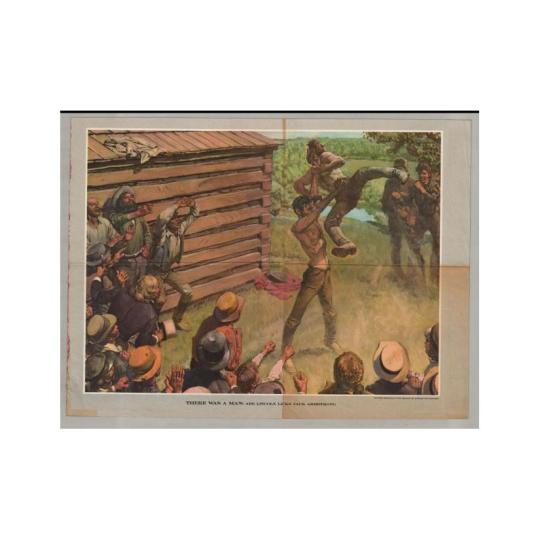
Print "There was a Man: Abe Lincoln Licks Jack Armstrong" by Harold von Schmidt for the July 1949 issue of Esquire Magazine. Image via www.lincolncollection.org.
The fight with Armstrong changed Lincoln’s entire persona in New Salem, making him a beloved and well-respected figure in the town. He became a voice of reason to the hijinks of The Clary’s Grove Boys, sometimes stepping in as mediator and diffusing disagreements before they came to blows. He also got his first taste of leadership, later being appointed as captain of the local militia unit and moving on to serve in the Black Hawk War. Perhaps the most surprising outcome was the bond between Lincoln and Armstrong who became extremely close friends after their brawl. As years went on Lincoln was welcomed into the Armstrong family home of Jack and his wife Hannah and he would often stay there both for friendly visits and when he found himself without work. When Jack and Hannah welcomed their son William into the world in 1833, Lincoln would often rock the baby to sleep during his visits. No one in the room could have predicted how their paths would cross one day.

Jack Armstrong. Image via http://www.mrlincolnandfriends.org/
Lincoln’s career in politics and law continued to grow steadily over the next decades but while Lincoln was building his fabled career in law the twenty-four year old William “Duff” Armstrong found himself on the other side of it. In August of 1857 a religious camp meeting held in Mason county Illinois was winding down after multiple days of congregating. On August 29th 1857, the night before the meeting was to officially conclude, Duff and some others were spending time around the whiskey wagons and they decided to sample the goods. After drinking heavily Duff lay down on a bench to sleep off the effects of the alcohol and he was left alone until approximately 8pm when a local farmer by the name of James P. Metzker rode his horse into the vicinity. Metzker was also intoxicated and he made the fateful decision to grab the sleeping man’s leg, spit in his face, and drag him to the ground waking the sleeping beast of Armstrong and causing the two of them to get into a heated brawl. According to Duff’s brother, A.P. Armstrong, the two men eventually stopped throwing fists and decided to have some more drinks together. He goes on to state that after this friendly exchange Metzker proceeded to get into another fight with another man that was drinking with them named J.H. Norris. Eventually Metzker left the scene on his horse, falling off several times in the process but eventually making it home. The only three that truly know what happened that night are Armstrong, Norris, and Metzker, but two days later Metzker was dead, having succumbed to two fractures to his skull that doctors concluded could not have come from him falling off his horse. The Mason County Sheriff arrested both Norris and Armstrong for the murder of James P. Metzker.

William "Duff" Armstrong. Image via hd.housedivided.dickinson.edu.
Armstrong was facing certain peril. Accused of cold-blooded murder alongside Norris, who had already escaped jail for a murder charge once before, the outlook was bleak. While awaiting trial in jail his father Jack Armstrong died but the man had a deathbed wish, he wanted to call in a favor from his old friend, the young attorney Abraham Lincoln, and ask that he defend his son in court. Hannah Armstrong wrote to Lincoln and his response was swift:
“I have just heard of your deep affliction and your son's arrest for murder. I can hardly believe that he can be capable of the crime alleged against him. It does not seem possible. I am anxious that he should be given a fair trial at any rate, and the gratitude for your long-continued kindness to me in adverse circumstances prompts me to offer my humble service gratuitously on his behalf.”
Lincoln packed his bags and traveled to Beardstown, Illinois ready to defend the man he once rocked to sleep as a baby in the battle for his life.

The Beardstown Courthouse where the Almanac Trial took place still standing today. Image via abrahamlincolnonline.org
The trial began on May 8th 1858 and the charges against Armstrong and Norris were grim, the indictment stating the Norris struck Metzker in the back of the head with a large piece of wood before Armstrong struck him in and around the right eye with a “slung-shot”, a metal weight held in a long strip of leather, causing “mortal bruises” that lead to his death. The prosecution greatly rested on the words of Charles Allen, a man who claimed he witnessed the assault and knew it was Armstrong and Norris because he could clearly see them by the light of the full moon overhead. It may have seemed like and open and shut case, Norris had a criminal past and Allen clearly saw the men attack Metzker. But then it was Lincoln’s turn to speak.
Up until this point Lincoln sat quietly in the courtroom, “with his head thrown back, his steady gaze apparently fixed upon one spot of the blank ceiling, entirely oblivious to what was happening about him, and without a single variation of feature or noticeable movement.…” When the time came for him to cross examine Allen, Lincoln had very specific questions for the star witness. When asked for details about that night Allen repeatedly insisted he saw it all happen from approximately 150 feet away, the brutal scene being lit by the full moon overhead “about where the sun would be at one o’clock in the afternoon.” Lincoln asked more questions, pressing him about the location and time of the crime over and over again. The camp meeting was taking place in a very densely wooded area that was quite dark at night. Lincoln joked, did Allen have a candle with him in order to see? But the witness persisted that he saw it all happen clearly in front of him and that his certainty was fully placed in what he saw under the light of the bright full moon. He was given every opportunity to change his words.
When Lincoln was satisfied that Allen was given a proper chance and that he had made himself clear about the moon lighting his view of the crime, he submitted into evidence an almanac that contained information about the night the assault occurred. The defense was swift and crushing. The pages of the almanac contained a wealth of information, including the position and phase of the moon the night of August 29th 1857 and it simply did not match the account of the witness. The volume was inspected by the court, the attorneys, and by Judge Harriott all of which confirmed the information on the page, at the time of the assault the moon was no where near a position to be illuminating the scene. Rather than being directly overhead as Allen stated, Lincoln said the moon was in fact setting, which would have left the scene amid the heavy forest in significant darkness, certainly not illuminated brightly enough to see the distinct faces of Armstrong and Norris.

Lincoln for the Defense painted by Norman Rockwell in 1962 depicting Lincoln during the Duff Armstrong trail. Image via https://www.lincolnshrine.org/
Everything the prosecution had deflated within moments as members of the jury and some in the courtroom burst into laughing. Judge Harriott commented that Lincoln was wrong about one thing, that according to the almanac the moon would have been coming up at the alleged time instead of going down as he stated. Lincoln’s response was simple, “It serves my purpose just as well, just coming up or just going down, as you admit it was not over head as Mr. Allen swore it was.”
With a simple turn of a page all credibility of the prosecution was destroyed. Lincoln had other evidence including a doctor stating the injuries to the front of Metzker’s face were the result of the blow to the back of his head, but it did not matter. The almanac sealed the deal in the minds of many present in the courtroom. As the jury went into the jury room Lincoln approached Hannah Armstrong and told her that her son would be “cleared before sundown”, a prediction that quickly came true. Within an hour the jury unanimously voted to clear Duff Armstrong of all charges.
After being reunited with his mother and getting a talk from Lincoln about how he needs to care for his mother and become the man his father was Duff Armstrong went on to live a long life, dying on May 5th 1899 at sixty-six years old. Norris, the man who allegedly inflicted the blow to the back of Metzker’s head, was convicted and this time he was unable to avoid jail. He was sentenced to eight years in a state penitentiary.
“The Almanac Case” became on of the most well know chapters in the law career of Abraham Lincoln and was even used in campaigns against him during his senatorial race and his later run for the presidency where opponents alleged that he used an altered almanac to keep his old family friends safe. Lincoln became the sixteenth President of the United States just two years later in 1860. He was honored by the National Wresting Hall of Fame with the Outstanding American Award in 1992. Today, visitors to the National Wrestling Hall of Fame can visit the Lincoln Lobby with a mural showing the famous brawl between Lincoln and Jack Armstrong that would lead to a lifelong friendship and save Armstrong’s son only two years before Lincoln became President of the United States.
*************************************************************
Sources:
Lincoln's Defense of Duff Armstrong by J. N. Gridley.
Journal of the Illinois State Historical Society (1908-1984), Vol. 3, No. 1 (Apr., 1910). https://www.jstor.org/stable/40194333
True Story of the Almanac Used by Abraham Lincoln in the Famous Trial of Duff Armstrong by Duncan Ferguson.
Journal of the Illinois State Historical Society (1908-1984), Vol. 15, No. 3/4 (Oct., 1922 - Jan., 1923). https://www.jstor.org/stable/40186950
Abraham Lincoln and the Case of the Altered Almanac by Mel Maurer
The Cleveland Civil War Roundtable, 2006.
“Duff” Armstrong Trial: 1858 Encyclopedia.com.
By the Light of the Moon: Abraham Lincoln's Adventure in Forensic Meteorology (Part 1) By Matt Soniak. Mental Floss.com Sep 13, 2011.
Is Abraham Lincoln in the Wrestling Hall of Fame? By Dan Evon. Snopes.com May 3, 2018. https://www.snopes.com/fact-check/lincoln-wrestling-hall-of-fame/
#husheduphistory#featured articles#history#AbrahamLincoln#LincolnHistory#legalhistory#famouscrimes#famouscourtcase#IllinoisHistory#weirdhistory#forgottenhistory#strangehistory#thefarmersalmanac#themoon#JackArmstrong#Getbywithalittlehelpfrommyfriends#historyclass
4 notes
·
View notes
Text
Forgotten for Football: The Horrific Thanksgiving Day Disaster of 1900
Since the late 1800s Thanksgiving and football have gone hand in hand with the fevered fanbase and anticipation staying strong over the centuries. The first college football game was played on Thanksgiving Day 1876 as part of the Intercollegiate Football Association Championship, and it did not take long for fans to choose their sides. By the time 1900 appeared on calendar pages the University of California Berkeley and Stanford University were already fierce rivals, playing against each other every Thanksgiving since 1892 in a clash that became affectionately known as simply “The Big Game.” People always had high expectations for the game, but no one walking into the event ever expected to encounter tragedy.
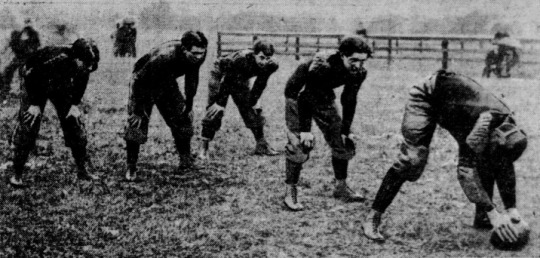
The Stanford University football team circa 1900. Image via Wikimedia Commons.
No one can say the warning signs were not there. In the early days of the game there were no stadiums and it was played in any large field or industrial area that could fit them. The last few Big Game events between University of California Berkeley and Stanford were played at Recreation Field in San Francisco and in 1897 grandstands were built to accommodate the crowds. These seats were not meant to last, they were built quickly to fit 10,000 people with meager roofs that were only put there to keep spectators dry and definitely not to be used for extra seating. But, that is exactly what happened in 1897. While over 15,000 people scrambled and squeezed into the stands to see the game many others looked for alternative means to watch. Contractor J.C. Weir saw the danger and tried to warn those in charge, but his words were ignored while waves of young boys climbed up the stands and crowded the roofs to set their eyes on the teams below. They almost made it through the entire game, but in the final moments the roofs began to buckle, and then they broke. Hundreds of children came crashing down onto those seated below them, intermingled with the wood and metal that was never meant to hold their weight. Some people were knocked unconscious, some were left bleeding but remarkably only one 10-year-old-boy was injured enough to seek medical care and everyone else was, for the most part, left unscathed. One witness to the collapse remarked that the fact that no one was killed or left with permanent injuries was “miraculous”, and indeed it was, but not enough for anyone to learn from it.
The collapse of the grandstands was the last thing on the minds of the attendees of the Big Game taking place on November 29th 1900. The games were always exciting and even though the tradition was fairly new, by 1900 the crowds were massive and the tempers hot despite the teams only having a history of nine Big Game encounters. Of the nine games, Stanford had won seven despite their football team only being founded the same year as their first game and tens of thousands of people couldn’t wait to see if University of California Berkeley would come roaring back. Like previous years, the game was to take place in San Francisco, and once again no one could have anticipated the sheer size of the crowd. It had rained earlier that morning, but when the weather passed the doors of the surrounding neighborhoods and the incoming train cars were swinging open leading to 19,000 people swarming Recreation Field by 10:30am. A ticket for the game cost one dollar, an amount that wasn’t an easy price for many younger fans that desperately wanted to watch the biggest event of their year. So, just as they did several years earlier, the fans got inventive. Some climbed water towers, others tried to dig under fences to get in, but there was one thing that seemed to be an obvious solution for those needing a bird's eye view of the Big Game.
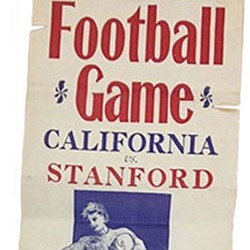
Flyer for the Big Game on November 29th 1900. Image via Stanfordmag.org.
Across from Recreation Field was San Francisco and Pacific Glass Works, a brand new factory that was gearing up to open on December 3rd. Those putting up the makeshift grandstands remembered the collapse of 1897 and they told those in charge of the factory that they were required to do everything possible to prevent anyone from gathering on the roof. The Superintendent of the factory James Davis was in complete agreement with precautions being taken and he was given six tickets to the game for his compliance, but when the time came the workers that were stationed to prevent anyone from getting on the roof were simply overwhelmed. People dug under fences to get to the grounds, flung open the gates, and they poured in. According to one witness, “It was like trying to turn back the waves at the beach. The kids kept pouring through the fence anxious to see the kickoff." Factory workers who could sense the danger went into the streets, looking for police officers to help control the crowd and get the people off the roof but they could not find anyone who could assist. Soon between 500 and 1000 people were crammed onto the factory roof that was only built to withstand forty pounds per square inch. Even if someone wanted to escape it was impossible to move through the crowd to do so. They all gazed ahead, not paying any attention to the tell-tale signs around them signaling the danger they were all in.
Twenty minutes into the game the crowds in the stands were electric. Their voices were roaring and the bands for Stanford and University of California Berkeley were booming, beating the thousands into a frenzy. The atmosphere on top of the glass works building was just as ecstatic, but in a matter of seconds it shifted to chaos. A portion of the roof of the building gave way and in a scene that was unfortunately familiar the fans began to fall. But, unlike the collapse of 1897 that had relatively minor injuries, this time the spectators fell into an absolute nightmare.
This building was a glass factory, and although it was not due to officially begin production just yet, it was partially operational in preparation for the opening day. One thing that was up and functional was a furnace, filled with fires strong enough to melt glass and with an exterior temperature of approximately 500 degrees. Working in the factory that day were Ignace Jocz and Clarence Jeter, and they could undoubtedly hear the roars of the crowd before humanity started to unexpectedly rain down on them from above. The hole in the roof opened at the worst possible spot and between sixty and one hundred people fell forty-five feet into the factory with some of them landing directly on top of the glowing furnace.
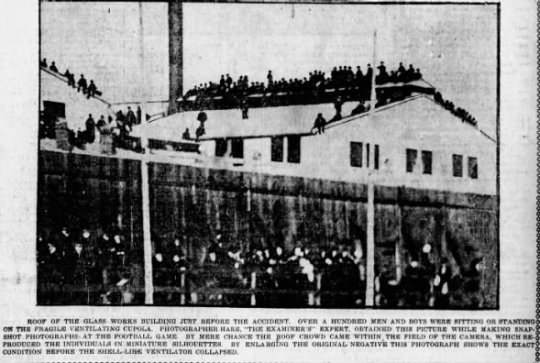
Image of the roof of the factory just before the accident. Image via 30 Nov 1900, Fri The San Francisco Examiner Newspapers.com
It's impossible to imagine the scene and the sounds that filled the factory as they all hit the metal or, if they were lucky, the brick floor. Once they hit most broke enough bones to render them immobile and those that hit the furnace stuck to the sizzling top. To make things even worse the furnace was encased by binding rods surrounding the machine in what was essentially a cage, trapping anyone who fell in the spaces. Those who missed the cage were just as unlucky, some of the falling bodies struck fuel pipes on their way down, severing them and sending boiling oil through the air and dousing the already burning bodies that then exploded into flame. Adding to this already unimaginable tragedy was the fact that almost everyone who plummeted through the ceiling that day were children, some boys as young as nine years old, that were the most likely to not have the dollar to buy a ticket and the least amount of concern about climbing to the roof of a building to watch the game.
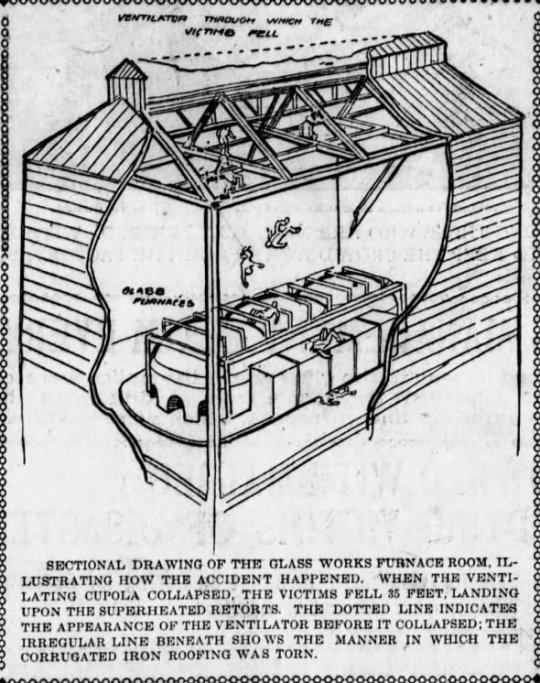
Illustration of the inside of the factory showing the furnace and binding rods. Image via 30 Nov 1900, Fri The San Francisco Examiner Newspapers.com.
Jocz, Clarence, and some other employees of the factory jumped into action doing what little could be done to attempt to save some of the victims, grabbing bodies and throwing them out of the way and using long metal hooks that were normally used to stir molten glass to hook people that landed on the furnace and drag them down. Watching the horrific scene from above were approximately twenty-seven people who also fell through the ceiling but somehow were able to cling to the rafters and the walls to avoid being roasted alive. One witness, young Thomas Curran, survived the ordeal by grasping a ceiling joist with his legs, forced to hang upside-down while chaos erupted under him. He later stated: “As I clung there, I saw the poor fellow who had been chatting with me strike the furnace. He curled up like a worm in that heat.” The sound of the bands and cheers of the game could still be heard filling the air.
Incredibly, the crowds gathered to watch the Big Game were greatly unaware of the tragedy unfolding nearby. Spectators heard the crash but some believed it was simply a planned distraction by the opposing team, with one fan yelling “It’s a job!” Others believed it was just normal sounds coming from the industrial park and within moments the focus was back on the field. Those who did know that something was amiss were the residents of the surrounding towns and they quickly began to swarm the factory, screaming the names of their sons who had gone off that morning to enjoy a football game. The masses also ran to the morgue and toward the wagons being driven by the coroner, some filled with bodies burned and disfigured beyond recognition and others filled only with what remained such as socks, shoes, neck ties, and the contents of small pockets. Every possible vehicle was summoned to help, and a frantic search began for doctors that could be pulled away from their Thanksgiving meals to help the deeply wounded masses that lay on the factory floor in sheer agony while the smell of burning flesh filled the air. As the players from Stanford were marched out onto the street for an impromptu victory parade to the nearby Palace Hotel, other streets were filled with the screams and frenzy of the tragedy that seemed to have happened in another world from the game that happened only two blocks away.
As the news spread that day as to what happened and the numbers began to rise the city was plunged into a deep state of sorrow. Hospitals became overwhelmed and the official count declared that thirteen people had died in the factory with eighty-six others critically wounded. As more recovered, others still died and soon the funerals began. On the following Sunday alone there were nine burials that had to take place back-to-back from 9am to 4pm.

Newspaper story about the accident. Image via 30 Nov 1900, Fri The San Francisco Examiner Newspapers.com.
Amazingly, reactions to what happened remained as separated in the newspaper pages as they did on the streets the day of the tragedy. The cover of the New York Times talked about the horror of the deaths at the glass factory, but the Sports section beamed of the Stanford victory as if nothing else had happened that day, calling the game the “closest and most exciting game of football ever played by the elevens of the two California universities." No players or coaches commented on the unspeakable horror that unfolded within earshot of the game that day. The college publications from both Stanford and University of California Berkeley carried on as if it never even happened with the Stanford Daily writing a 1,500-word front-page story about the victory with no mention of the tragedy other than a casual mention of a potential rematch to raise money for the affected families that never ended up happening.
Although the city of San Francisco felt the deaths deeply, it seemed they too wanted to move beyond it as quickly as possible. When a grand jury was assembled to determine who was at fault for the Big Game disaster it had an air about it that seemed like it was purely for appearances. The blame was placed on James Davis as the Superintendent of the San Francisco and Pacific Glass Works and then it shifted to the police for not assigning enough people to the game. Shockingly, with no one to blame and people wanting to simply move on, the blame shifted to the dead. Seven days after the tragedy, and with victims still succumbing to injuries, the jury declared that “[T]he deceased had no business being there...No one can be held responsible for their deaths other than themselves." No one fought them on this. In the minds of most, the story of the collapse was over.
The newspapers and courts might have decided the case was closed, but for many what happened that day never went away. On December 4th 1900 young Fred Lilly died in the City and County Hospital after suffering for months from a fractured skull he sustained in the fall. He never fully regained steady consciousness but in moments of delirium he still acted as if he was watching and enjoying the football game that was playing in front of him before everything suddenly stopped. Three years after the roof collapse twenty-eight-year-old Thomas Pedler passed away after enduring spinal surgery, paralysis, and the amputation of both legs. His demise marked the twenty-third and last death resulting from the disaster, fifteen of which being children that died before their eighteenth birthday.
To this day the tragedy, known now as the Thanksgiving Day Disaster or The Big Game, is the deadliest accident to ever happen during an American sporting event. Now the glassworks building is gone, replaced with a building belonging to the University of California. The gravestones are also gone and most of the final resting places of victims disappeared from memory and fell into ruin after San Francisco introduced regulations forbidding new burials, also in the year 1900. One small reminder of the incredible catastrophe can be found in the Holy Cross Catholic Cemetery just south of the city. Here lies a tiny stone cross that was meant to only be a temporary marker. It is inscribed with the name Cornelius McMahon, a twelve-year-old boy who died in the Thanksgiving Day Disaster and now remains as the only physical reminder of the deadliest day in American sports history.
*****************************************************
Sources:
“The Big Game Disaster of 1900” by Sam Scott. Stanford Magazine November/December 2015.
“Big Game was marred by tragedy in 1900 contest” by Edvins Beitiks. November 17, 1997.
“The Thanksgiving Disaster that Most People Haven’t Heard About” by Marina Manoukian. November 19, 2022.
“Sudden Death: Boys Fell to Their Doom in S.F.'s Forgotten Disaster” by SR Weekly Staff. Aug 15, 2012.
“Thanksgiving Day Tragedy” ThePigskinDispatch.com
https://pigskindispatch.com/home/Football-Fun-Facts/Random-Football-Facts/Stadium-Disasters/Stanford-Vs-Cal-1900-Tragedy
#HushedUpHistory#featuredarticles#history#CaliforniaHistory#SportsHistory#tragichistory#horriblehistory#Footballhistory#TheBigGame#ThanksgivingDayDisaster#historyclass#strangehistory#forgottenhistory#tragictale#truestory
2 notes
·
View notes
Text
Out of Sight, Out of Mind: The Disregard and Disappearance of the Irish Crown Jewels
The Crown Jewels of Ireland were a sight to behold. Crafted from over 300 Brazilian diamonds, emeralds, and rubies, they were a symbol of British power in Ireland and belonged to The Order of Saint Patrick, founded in 1783 by George III. Although the Order was not tied to the monarchy and were more of an elite aristocratic order akin to the Order of the Garter, their weight in symbolism was heavy. When the order was restructured in 1831 William IV used jewels sourced from the English Crown Jewels of Queen Charlotte and the Order of the Bath star of George III to create what would come to be known as the Crown Jewels of Ireland.
The jewels were often included in major events and that was the plan in the days before the 1907 Irish International Exhibition. This was a major event for Ireland, King Edward VII and Queen Alexandra would be in attendance and part of the ceremonies included the induction of Bernard FitzPatrick, 2nd Baron Castletown into the Order of Saint Patrick. Of course the Irish Crown Jewels, the symbols of the Order that were crafted from the treasures of the British throne, were needed for the ceremony. There should have been nothing to worry about. After all the jewels were held inside a safe in Dublin Castle where they were guarded by the Ulster King of Arms, his staff, and an outdoor patrol of police and soldiers that kept guard around the clock. But, just four days before King Edward VII and Queen Alexandra arrived the Irish Crown Jewels vanished without a trace.
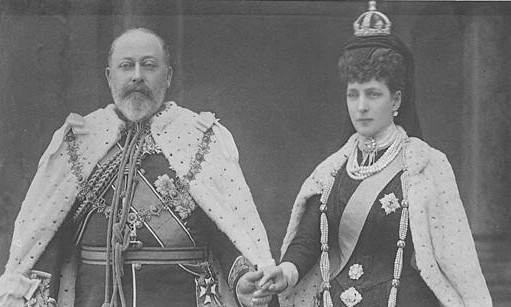
King Edward VII and Queen Alexandra. Image is public domain.
The trouble began years earlier in 1901 when it was decided that the Ulster King of Arms should have his office moved deeper into the structure of Dublin Castle. The Ulster King of Arms was prestigious in Ireland, a role that oversaw the rules regarding heraldry and family trees. In 20th century Ireland this was a very important job, one that basically decided the lines of inheritance. Another part of the job was to be the overseer of the jewels. The Ulster King of Arms at the time, Arthur Vicars, was all in favor of the move but he also had some suggestions. According to him the jewels should not be part of his quarters, they should be kept in a large safe and then placed in a strongroom. The idea was agreed upon but in 1903 when the safe holding the jewels was meant to be moved to the new strongroom, it proved to be impossible. The safe was too big and would not fit through the door to the newly constructed room built specifically for the safety of the jewels. Vicars and the crew responsible for the move came to a less-than-optimal conclusion, the safe would be moved to Vicars’s library inside Bedford Tower.
The move to the library was only supposed to be temporary until the problem of the safe fitting through the door could be fixed. But the moment the safe and the jewels were placed there it seems Vicars washed his hands of the issue. True, the safe was heavy and meant to be burglar-proof but the new location of the safe was not helping the cause. The library was also the waiting room to Vicars’s office meaning there was a steady stream of people milling around the safe on a regular basis. The library also had several doors in and out of it that were guarded, but the guards could not actually see the safe from any of their posts. All of these were concerns but perhaps the biggest issue was Vicars himself.
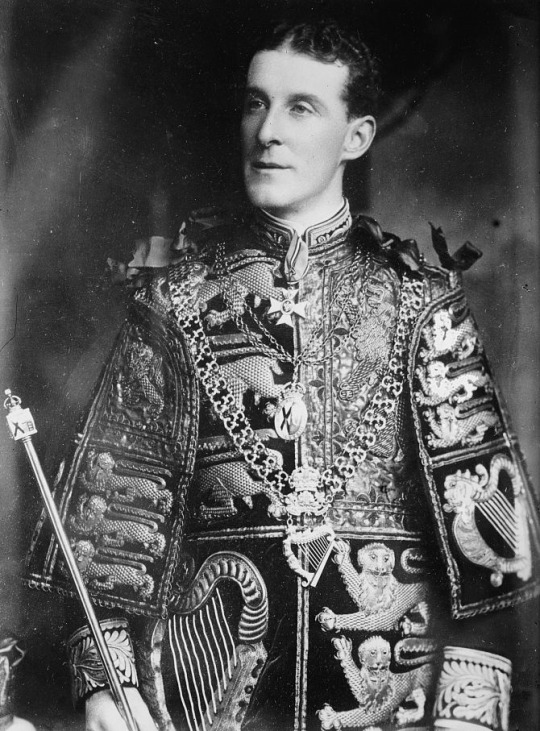
Sir Arthur Vicars. Image is public domain.
Arthur Vicars was forty-five years old and was appointed as Ulster King of Arms in 1893. He was extremely dedicated to the part of his job that entailed overseeing heraldry and genealogy, but too often he seemed to have very little interest in the Irish Crown Jewels and watching over them. There were several different keys associated with the jewels and their safekeeping. Four keys to the outer door to the strongroom went to Vicars, his secretary, his nephew who was also his assistant, and a sentry named Stivey. There were two keys to the inner door of the strongroom, one that belonged to Vicars that he kept in his office and another that typically stayed inside the lock unless Stivey moved it into a drawer where anyone could find it. But, the jewels were not in the strongroom, they were in the library inside a safe that only had two keys, both of which Vicars had in his possession. One of these keys he kept on him and the other one was hidden in a drawer in a bookshelf in his home.
These keys should have been a priority for Vicars, but in reality he had a very rough history with them. Vicars enjoyed showing off the jewels, but there were multiple security breaches that should have put their safety into question. On multiple occasions leading up to the disappearance his keys were misplaced or found totally unattended. On June 28th 1907 Vicars lost his keys and had to be let into Bedford Tower by the police, the keys were not found for a week. On another occasion a cleaning woman found the door to Bedford Tower unlocked early in the morning, something that Vicars seemed completely unconcerned about. Just over a month before the disappearance the key to the safe was found by the same cleaning woman attached to a keyring with multiple other keys. The keys were placed in a drawer and eventually made their way back to Vicars through several sets of hands and multiple steps. This was a big enough problem, but it went beyond simple forgetfulness and crossed the line into negligence. There was one occasion where Vicars got drunk only to wake up with the jewels draped on his chest. Another instance involved a drunk Vicars and his friends who were able to sneak off with his key, steal the jewels, and send them back to him through the mail as an elaborate prank. Perhaps these “pranks” were what made his behavior on July 6th 1907 so very odd.
On that fateful July morning the same cleaning woman who had previously found the misplaced keys arrived at Bedford Tower and soon discovered that the outer door to the strongroom was unlocked. The inner door was still locked but the key was still sitting in the keyhole, attached to a ring with other keys to various places in the tower. Clearly by now this was not an unusual occurrence, she wrote a note for the sentry and left the keys for him to return them to Vicars whenever he arrived for the day. When the sentry found the note and keys and tried to return it to Vicars he shrugged it off and continued about his work, he was very busy planning for the visit from King Edward VII and Queen Alexandra. There was no suspicion or alarm in his mind, but there should have been. The safe was the home of the jewels but it also held a number of gold collars worn by members of the Order of Saint Patrick. Hours after Vicars was told about the strongroom being found unlocked a representative from Dublin jewelers West and Son was returning one of the golden collars to the tower after repairing it. The collar was given to the sentry and Vicars gave him his key to the safe, telling him to put the collar back inside. The sentry approached the safe and turned the key to open it, except he discovered that the safe was already unlocked. The sentry ran back to Vicars and they both rushed back down to the safe. When Vicars opened it they were met with the worst possible scenario. The contents of the safe, all the gold collars, prized family jewels, and the Irish Crown Jewels were completely gone.

Notice of the missing jewels. Image via wikipedia.com.
The Dublin Metropolitan Police were immediately summoned to Bedford Tower. It was obvious that the irreplaceable items were gone, but that seemed to be the only straightforward thing about it. The doors to the tower, the strongroom, and the safe were all opened without a scratch indicating they were not forced. The only explanation for this would be if the culprit was somehow able to make copies of the keys, or that they somehow had the original keys themselves at the time of the robbery. And then there was the ribbon. The badge of the Irish Crown Jewels were attached to a sky blue ribbon by a small hook. The ribbon was fixed to the hook by a very small clasp and fastened there by two very tiny screws. The ribbon could have been ripped off but instead whoever took the jewels decided to take the time to painstakingly undo the small screws and remove the ribbon before laying it in the safe. This was not a fast process and Vicars said it could have taken as long as ten minutes to accomplish. Besides the ribbon all wrappings and cloth that held all the jewels were folded and carefully placed back inside the safe as well. This was not a rushed job, whoever did this knew exactly what to do and took their time doing it.

Illustration of the ribbon attached to the jewels. Image is public domain.
There were many directions for the investigation to go, but originally the Dublin Metropolitan Police could not find any credible leads so Scotland Yard was called in. Oddly, after their investigator explored avenues, came up with suspects, and wrote up reports, he was removed from the case and he returned back to London placing the case back into the hands of the Dublin Metropolitan Police. At first Vicars was adamant that no one on his staff would have stolen the jewels and insisted that maybe they would just show back up on their own, perhaps desperately hoping this was just another prank.
If this was a prank, it was one with massive consequences. The jewels disappeared only four days before the arrival of King Edward VII and Queen Alexandra, they came directly from the British royal family, the castle was the British administration's base in Ireland, and the now lost jewels were seen as symbolic of their reign. Furthermore, the jewels were supposed to be part of an important ceremony during the Irish International Exhibition. All of this was bad enough, but the theft became a very public scandal with newspapers blasting the incident on every headline effectively embarrassing the British royal family and making a mockery of the British rule in Ireland. King Edward VII was absolutely furious with one member of the royal household staff saying that he had “never seen King Edward so angry…His rage was something terrible and fearful... I am sure the officials he lectured never forgot his words." The royal visit to the Irish International Exhibition went on, but the ceremony inducting the new members into the Order of Saint Patrick were cancelled.
It shouldn’t have been a difficult case to solve, after all there were only two keys to the safe and the pool of suspects should have been very shallow. But, Vicars and his past with the jewels made everything much more complicated. They were stored in his library that had people around it all the time. Vicars made it very clear that the jewels were low on his priority list. He regularly misplaced the keys to the strongroom and, even worse, to the safe. He shrugged off multiple warning signs that something was very wrong when doors and keys were previously found unlocked and misplaced. And then there were the times when he woke up wearing them after a night of drinking and the “prank” where the jewels were stolen and arrived back home a week later in the mail.
But even though the list of suspects and theories were long, there was still the ribbon and boxes to consider. The safe and doors were totally unscathed and time and care was taken to put the wrappings and the ribbon back. This was no fast smash-and-grab robbery and it could not have been committed by anyone totally unfamiliar to the tower. Yes, Vicars said no one on his staff would have stolen the jewels, but there were so many variables to consider it was hard to outright rule anything out. The news of the theft and the hefty reward for information leading to them being found resulted in an overwhelming number of tips that all went nowhere. One that caught the attention of Vicars was from a woman who claimed that her daughter had visions about the location of the stolen jewels. Vicars had his close friend Francis Shackleton set up a séance with this woman and her daughter during which he was told that the jewels had been buried at a cemetery in a small town outside of Dublin, a statement that could have applied to two different cemeteries. Hoping for a miracle, Vicars went to both cemeteries to dig, but he ultimately found nothing. The only ones to benefit from the trip was the press who only criticized Vicars even more for the attempt.
The theories were all over the map. Some thought the crime was committed by Irish nationalists looking to embarrass the British king, others think it was a failed scheme hatched by unionist officials hoping to embarrass nationalist Lord Aberdeen and get him removed from his office. Names spun around including Vicars himself, the sentry, Vicars’s nephew and assistant Pierce Gun Mahony, and the tower guards. One name though, kept coming back into conversation and gained a lot of attention until the buzz was silenced. That name was Francis Shackleton.
Everyone knew Francis Shackleton for one reason or another. The younger brother of famous Antarctic explorer Ernst Shackleton, he moved his way up from his middle-class Irish upbringing into the upper crust by keeping powerful friends and charming his way into exclusive circles. He was very close friends with Vicars, so close that Vicars granted him the title of “Dublin Herald” in the Office of Arms and Shackleton lived with Vicars in Dublin for two years when he wasn’t spending time in London. This connection and title meant that Shackleton was at any social event and rubbing elbows with the likes of 9th Duke of Argyll (the brother-in-law of King Edward VII), but it also gave him protection. Shackleton was a gay man living in Ireland in the early 1900s, something that was not only looked down upon, but was illegal. He and his lover, former military captain Richard Gorges, were well known and they both had unrestricted access to Bedford Tower and the home of Vicars.
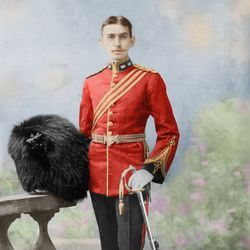
Portrait of Francis Shackleton. Image is public domain.
Shackleton definitely had access to the keys and the jewels, but what was the motive? The Dublin Herald presented himself as having unlimited finances but in truth he was horrible at handling his money, often having to rely on loans and illegal means to fill his pockets. At the time of the disappearance of the Irish Crown Jewels Shackleton was embarking on a new venture, investing money in huge parcels of land in Mexico, but his finances were stretched precariously thin. There was more than enough signs pointing to Shackleton, but there were two problems. For one, he had a solid alibi. He was in England and did not return until after the jewels were already gone. Another reason dug far deeper than anyone, including the king, was willing to go.
When investigating Shackleton the stories began to creep out about lavish secret parties thrown at the castle with an exclusive guest list that included Shackleton, the son of the Lord Lieutenant who represented the king in Ireland, aristocrats, businessmen, and “some of Dublin’s leading homosexuals.” The rumors began to swirl about what happened at these parties and the king’s secretary informed him of some “scandalous conduct” at the castle. There is speculation that this is why the investigators from Scotland Yard were abruptly told to cease their investigation and return to London, that King Edward ordered it stopped because of what could be uncovered if Shackleton decided to talk. The reports compiled by Scotland Yard about the disappearance of the Irish Crown Jewels also vanished without a trace and has never been found.

Bedford Tower circa 2013. Image via Wikimedia Commons.
One person who was very vocal about their feelings on Shackleton’s guilt was his former friend Vicars. While being questioned after the jewels went missing he said they “were taken by a man you know well. He was a guest in my house, and he treacherously took impressions of my keys when I was in my bath. He often came to this office on Sundays, and he used my latch key to get in. He is in Paris at this moment.” Vicars turning on Shackleton was probably less out of loyalty to the jewels and more about loyalty to himself. Vicars knew he was going to be made the scapegoat in this case and when he was asked to resign his position as Ulster King of Arms he adamantly refused and demanded a public inquiry. The Lord Lieutenant instead assembled a viceregal commission in January 1908 during which the big question of the Irish Crown Jewels shifted from who could have stolen them to asking if Vicars “exercised due vigilance as the custodian of the jewels.” There was simply no case. The history between Vicars and the jewels was no secret, but even if it was, King Edward VII would hear none of it. On January 30th 1908 Vicars was fired from his position. The following July his private library consisting of books and manuscripts he compiled during his time as Ulster King of Arms was sold at auction at Sotheby’s in London. And yet, the nightmare was still not over for Sir Arthur Vicars. In November of 1910 the Chief Crown Solicitor reported that Vicars was still in possession of a “badge of gold provided for the service of the Registrar of the Order of St. Patrick” and demanded it back stating that it was property of the king and he needed to return it immediately. Among all the whispers, accusations, and having his life turned upside-down Vicars did have one small victory in 1913 when he successfully sued the London Daily Mail for an article that insinuated that he was the man behind the disappearance of the jewels. The same year that Vicars finally won a small battle against the accusations of his involvement, Francis Shackleton was also seeing some legal ramifications for his shady business dealings. In 1913 the “other” famous Shackleton and socialite was found guilty of fraud and sentenced to fifteen months in prison.
Once released from prison Shackleton tried his best to disappear from the public eye and the remainder of his life was kept very quiet. He was never formally accused of having any involvement in the disappearance of the Irish Crown Jewels. After his dismissal from the position he lived and breathed for, Vicars retired to County Kerry. In 1917 he married Gertrude Wright, but their union was short lived. On April 14th 1921 Sir Arthur Vicars was shot and killed at his home by a local IRA unit.
The Irish Crown Jewels were never found and remains one of Ireland’s greatest mysteries.
************************************************
Sources:
Royal raid: The curious case of the Irish Crown Jewels by Matt Fox. BBC.com. 2022.
https://www.bbc.com/news/uk-northern-ireland-62924392
The Theft of the Irish Crown Jewels, 1907 by Tomás O’Riordan. History Ireland. 2001.
https://www.historyireland.com/the-theft-of-the-irish-crown-jewels-1907/
The history of the Irish Crown Jewels by British Heritage Travel. 2023.
https://britishheritage.com/history/irish-crown-jewels
A Very Irish Scandal: The Gay Rumors Behind the Unsolved Irish Crown Jewels Heist of 1907 by Brigit Katz. Mental Floss. 2022.
https://www.mentalfloss.com/posts/irish-crown-jewels-theft-gay-scandal
The Greatest Unsolved Heist in Irish History: Scandal, conspiracy, and cover-ups in the theft of the “Irish Crown Jewels” from Dublin Castle by Dan Nosowitz. Atlas Obscura. 2021.
https://www.atlasobscura.com/articles/irish-crown-jewels-theft
#husheduphistory#featuredarticles#Ireland#IrishHistory#RoyalHistory#BritishRoyalHistory#crownjewels#truecrime#crimehistory#famouscrimes#stolen#unsolved#unsolvedmysteries#weirdhistory#truehistory#strangehistory#historiesmysteries#truestory#mystery#historyclass#truth is stranger than fiction#history#truefacts
1 note
·
View note
Text
Hammersmith: A Haunting, A Hoax, and a Tragic Hunt
The calendar page had barely turned over to the new year and twenty-nine-year-old Francis Smith was experiencing one of the worst times of his life. He sat before the court positively morose for what he had done. On that awful night of January 3rd 1804 he immediately surrendered to the constable, deeply regretting how it all unfolded. Now all he could do was plead for mercy and understanding. After all, at that moment he truly believed he was acting on behalf of the entire borough when he shot the gun.
Over the course of twelve months the West London district of Hammersmith fell into a state of apprehension and deep fear. It all began when a man committed suicide by slashing his own throat and, in a move that went against all rule and beliefs, he was buried in the consecrated ground of the churchyard ensuring that his soul would never find peace. It was after this controversial burial that people began to report seeing a figure, draped in a white shroud, appearing throughout Hammersmith. Surely this had to be the tormented spirit of the man who committed suicide and was then committed to sacred ground. What other explanation could there be? If the incidents remained as ghostly sightings it may have never progressed beyond a simple haunted tale, but the encounters got violent, and then people allegedly began to die. A brewer’s servant named Thomas Broom later told how he was walking through the churchyard with a friend one night when he was suddenly grabbed violently by the throat. It was only when his friend turned to see what happened that he claimed the specter “gave me a twist round, and I saw nothing; I gave a bit of a push out with my fist, and felt something soft, like a great coat.” Another pair of stories alleged that an elderly woman and a pregnant woman both encountered the malevolent spirit on separate occasions near the churchyard and they were both so terrified that when they returned home they could not leave their beds, dying there a few days later.

An image of the Hammersmith Ghost attacking a woman. Image via The Newgate Calendar, Part III (1826), http://www.exclassics.com/newgate/ngconts.htm.
The people of Hammersmith were scared but some were also skeptical, believing this was not a ghost, but a cruel and devious human being. Ghost or human, either way their reign of terror had to be stopped. At this point Hammersmith did not have a formal police force so in order to protect the people some of its own citizens began patrolling the streets after dark. One of these men guarding the night was Francis Smith, armed with a shotgun, and another was night watchman William Girdler. On the night of January 3rd at approximately 10:30pm Girdler ran into Smith and told him that later that night he would meet up with him and they would look for the ghost together. Girdler knew what he was looking for after all, only a few days earlier on December 29thhe saw the ghost and chased him down but the figure disappeared into the darkness.

Engraving of the Hammersmith Ghost appearing in Kirby's Wonderful and Scientific Museum circa 1804. Image via Wikipedia.
Another man walking the streets that night was thirty-two year old bricklayer Thomas Millwood. He was visiting with his sister, mother, and father and as the clock moved closer to 11pm he stood up, said goodnight to his parents, and prepared to head back home for the evening. His sister Anne watched him walk away from the door. She wished he had listened to her and worn something over his work clothes of linen pants, a waistcoat, and an apron. They were recently washed and glowed bright white in the darkness. He had already been mistaken for the notorious Hammersmith Ghost at least twice before but he met any accusation with a scoff.
Within minutes she heard the voice, “Damn you. Who are you and what do you want? I’ll shoot you if you don’t speak.” Then she heard the gunshot.
Anne ran out into the dark and before long she made the horrifying discovery of her brother laying in the road, dead in a pool of blood, with his face mauled by a bullet. She was not alone with her brother, already with his body was nearby wine merchant John Locke, William Girdler, and Francis Smith. What happened spilled out of their mouths and fell into place quickly. Locke heard the gunshot and soon afterwards Smith rushed up to him, severely distressed, and told him he had just shot a man and asked him to go back to the scene with him. After they got back to Millwood’s body they were quickly joined by Girdler and Anne Millwood. When the constable arrived at the scene Smith accepted full responsibility for what happened. He was taken to Newgate Prison to await trial and the body of Thomas Millwood was taken to Black Lion Inn where it was examined by a surgeon who determined that the bullet went through his jaw and hit his spinal cord killing him instantly.
Smith’s trial began one week later and it might have seemed like a fairly straightforward case. He did admit to shooting Millwood, but it was not that simple. Despite taking responsibility for Millwood’s death, Smith entered a plea of Not Guilty based on his account that he felt he was not hunting an actual ghost, but a person acting as a ghost and terrorizing Hammersmith. When he saw the white figure he knew he was facing a man and he called out to him twice, telling him to name himself. When he did not stop or speak Smith said he became fearful for his life because the figure kept approaching him. He shot, but did not aim to kill, it was just an all around unfortunate accident. There were no witnesses to the crime so heavy reliance was placed on the few who arrived at the scene. Locke stated that when Smith met him and asked him to accompany him back to Millwood he was genuinely distraught and horrified at what happened. Several others testified about Smith’s honesty, integrity, and all-around good character. The only voice that spoke of any faults came from Anne Millwood who told the court that Smith shot so quickly after calling out for her brother’s name that there was no way he could have responded in time.

Illustration of the encounter between Smith and Millwood. Image via crimemagazine.com.
Smith had people vouching for him, but the judge Lord Chief Baron Macdonald was hearing none of it. He addressed his jury and plainly explained that there was no gray area here, that it was either murder or it was not. Smith went out into the night carrying a gun which spoke to his intent to harm someone. Millwood was simply walking home when he met his end. In the judge’s eyes this was not self-defense and Millwood was doing nothing to warrant Smith shooting his gun. According to him, it did not matter who Smith intended to hunt down. It also did not matter if Millwood was deliberately dressed as a ghost to scare the residents of Hammersmith, that offence did not deserve being shot. According to the judge no matter how the situation was spun, it occurred because of malice and this was why Smith must be found guilty of murder.
Surprisingly, the jury did not go along with the judge’s advice and when they returned it was with a verdict of guilty, but guilty of manslaughter. This was not accepted by Lord Chief Baron Macdonald and his fellow judges once again reminded the jury that they could not find Smith guilty of manslaughter, because it was not a possible outcome when the choices were either guilty of murder or acquitted of murder. Once again the jury consulted with each other and finding no other option, they returned with their verdict: Francis Smith was guilty of murder.
With the verdict came the sentence. Smith was sentenced to death by hanging followed by dissection the following Monday. Inconsolable, Smith had to be held up and carried from the court.
However, as hard-lined as Lord Chief Baron Macdonald was he was well aware of the public opinion that Smith did not deserve to be sentenced as a cold blooded killer. He added “The case gentlemen shall be referred to His Majesty immediately” to his judgement. This gave Smith one more chance, when a case was brought before the King he had the ultimate power to override and change the sentence. For Smith, those few words from Lord Chief Baron Macdonald saved his life. Before the sun rose the next morning his sentence was reduced to one year imprisonment with hard labor.
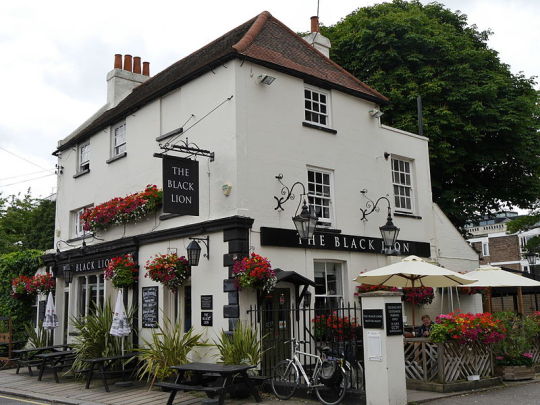
The Black Lion Inn, where Thomas Millwood’s body was taken and where Smith allegedly spent time before the shooting. Image via Wikipedia.
The Hammersmith Ghost, the terrifying being who attacked innocent citizens and was allegedly responsible for suffering, turmoil, and even death, was never heard from again. This is because two days after the death of Thomas Millwood the ghost came forward. A local shoemaker named John Graham admitted that he was the Hammersmith Ghost and that he had been dressing up as the specter to scare his apprentices as an act of revenge because they had been scaring his children with ghost stories. Graham surrendered to the authorities, but because there was no clear legal guidance on this situation he was set free on bail and all traces of him disappeared from record.
Francis Smith was given a full pardon on July 14th 1804.
While the haunting hoax promptly ended, the Hammersmith Ghost trial had far reaching implications when it exposed that there was very little defined in law when it came to people who acted out in a scenario where they believed action was required and carried out under good intentions or when the person acting out misread the situation. Did mistaken belief warrant a criminal charge? Smith was responsible for the death of Millwood, but he believed he was acting against someone who was bringing terror to the people of Hammersmith. The scenario would be brought up in a number of legal cases until it was finally settled in 1983 with the case of Regina v Williams during which the Court of Appeal finally clarified that:
“In a case of self-defence, where self-defence or the prevention of crime is concerned, if the jury came to the conclusion that the defendant believed, or may have believed, that he was being attacked or that a crime was being committed, and that force was necessary to protect himself or to prevent the crime, then the prosecution have not proved their case. If however the defendant’s alleged belief was mistaken and if the mistake was an unreasonable one, that may be a peaceful reason for coming to the conclusion that the belief was not honestly held and should be rejected. Even if the jury come to the conclusion that the mistake was an unreasonable one, if the defendant may genuinely have been labouring under it, he is entitled to rely upon it.”
In 1804 the people of Hammersmith were living in fear of a supernatural entity. This ghost story is still told, but not in front of campfires or on gloomy nights when the veil feels thin. The Hammersmith Ghost died in the same moment as Tom Millwood and today it is carried on not as a spine-chilling story about West London, but as a cautionary tale and a legal precedent that hung over the courts and haunted law practitioners for almost two centuries before it was finally laid to rest.
*******************************************************************************************
Sources:
The Case of the Murdered Ghost
http://news.bbc.co.uk/1/hi/england/london/3364467.stm
The Hammersmith Ghost and the Strange Death of Thomas Millwood by Martin Baggoley http://www.crimemagazine.com/hammersmith-ghost-and-strange-death-thomas-millwood
The Case of a Ghost Haunted England for Over Two Hundred Years by Kelly Buchanan https://blogs.loc.gov/law/2015/10/the-case-of-a-ghost-haunted-england-for-over-two-hundred-years/
The Time Someone Shot A Ghost Dead In Hammersmith by Jane Alexander https://londonist.com/london/features/hammersmith-ghost-story-murder
#husheduphistory#featuredarticles#Britishhistory#LondonHistory#legalhistory#paranormalhistory#ghoststory#famouscourtcases#tragictale#tragichistory#weirdhistory#strangehistory#forgottenhistory#creepyhistory#historyclass#history#oddhistory#truth is stranger than fiction#truestory#hoax#tragicmistake#ghost#courtroom
5 notes
·
View notes
Text
Unknown and Carved in Stone: The Murky Mystery of the Moon-Eyed People
History and folklore live in the same neighborhood. They are spoken, documented, passed down, and sometimes they cross paths and give each other a knowing nod, the weight of which only they fully understand. Fort Mountain State Park in Chatsworth, Georgia is one of those places where history and folklore meet. The story is a strange one and it covers a lot of miles, stretching from Alabama all the way up to Delaware. But in Murphy, North Carolina the words are allegedly given a shape. Enclosed in a case inside the Cherokee County Historical Museum they rest, standing upright, with their eyes gazing out and inviting visitors to stare back just as intently. They look unlike any other ancient form of art found in the Southeast and their story is just as unusual as their appearance. They are an alleged stone representation of the ancient Appalachian Moon-Eyed People.

The Appalachian Mountains of North Carolina. Image via Wikipedia Commons.
The Cherokee people have a vibrant culture that is filled with deeply cherished myths, legends, and histories of their people and their ancestral home in the mountains of Southern Appalachia. According to the Cherokee, the Smokey Mountains were formed by a giant buzzard after the giant flood. The exhausted bird fell to the earth and the mountains erupted up from where the massive wings impacted the ground. In the years since the creation of the mountains the Cherokee interacted with many spirits, many creatures, and according to their oral tradition, a civilizations of people that was there before them with extremely pale white skin, fine hair, and eyes that were so sensitive to the sun that they spent the daylight hours living underground.
The first written account of these people comes from European botanist Benjamin Smith Burton (sometimes written as Barton) who wrote in 1797 that he learned about these people from the firsthand account of Colonel Leonard Marbury, an intermediary between the American government and the Cherokee tribe. Burton writes:
“…the Cheerake tell us, that when they first arrived in the country which they inhabit, they found it possessed by certain 'moon-eyed-people,'who could not see in the day-time.”
The Cherokee people had a strong belief in things most people today would consider supernatural, but in their stories of the Moon-Eyed People they were never referred to as something otherworldly. They were considered and spoken about as another culture of human beings, ones that were living in Appalachia before the Cherokee arrived. John Haywood was one of America’s earliest historians and he collected the stories that were passed down through generations of the Cherokee people. Among the stories he documented, some were similar to accounts reported by Burton, that the Cherokee arrived at the mountains and along the Tennessee River they encountered “white people” and fortifications that contained “hoes, axes, guns, and other metallic utensils.” Then there were the fortifications themselves, made of precisely arranged stone, and stretching all the way from the Tennessee River down to the Chickamauga Creek. Were these fortifications created for protection from nature or people?
The Cherokee stories do not mention finding any other civilizations of people along their travels and when these two groups met, they clashed. The text from Burton states “These wretches they expelled” and in his 1823 book Natural And Aboriginal History of Tennessee Haywood writes of “white people, who were extirpated in part, and in part were driven from Kentucky, and probably also from West Tennessee.” Writer James Mooney was familiar with the works of Burton and Hayward as well as the Cherokee oral traditions having collected stories from two Cherokee elders who told that when they first came to the region they encountered people who were “very small and perfectly white” that were then driven from the area and fled west. The story continues that the conflict took both groups of people to Big Chickamauga where an agreement was made that these “very small and perfectly white” people were not permitted back to their land and fortifications, but they were permitted to flee in peace.

The fortifications of Fort Mountain as they appear in modern day. Image via Wikimedia Commons user Thomsonmg2000.
Descriptions of the “Moon-Eyed People” continue to appear in multiple accounts collected from the Cherokee with slight variations. Some describe them as being extremely small, others say they could only see during certain phases of the moon and that they lived underground, another version describes them as tall with light-colored hair and speaking a strange language. While many historians question if these people even existed, those who believe they did have another question to answer. Who were these people? Where did they come from? A popular theory says that that answer can be found by tracing a line that stretches from Georgia across the Atlantic Ocean to Wales.
When the governor of Tennessee John Sevier visited Fort Mountain, Georgia in 1782 he met with the Cherokee’s Chief Ocotosota. At the time of their meeting Chief Ocotosota was ninety years old and when discussing the large stone fortifications standing at Fort Mountain he told the governor that his forefathers "told of the fort being built by white men from across the great water." The accounts from Chief Ocotosota were enough to convince Sevier. There was another story that claimed to tell the origin of those in the Appalachia before the Cherokee and based on the accounts of Chief Ocotosota he believed the tale to be the truth. According to this version of events the mysterious Moon-Eyed People were the descendants of a Welsh prince.
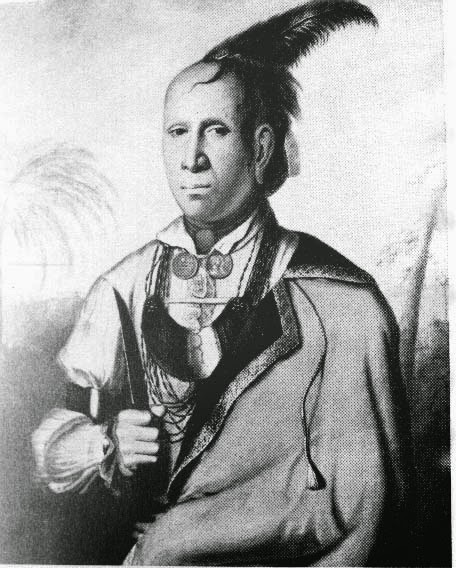
Oconostota, Cherokee chief from a painting entitled "The Great Warrior, Chief Oconostota-Cunne Shote" by Francis Parsons, 1762.
Image and caption credit: Tennessee State Library and Archives
The story of Prince Madoc ab Owain Gwynedd is intriguing, but also murky. The story tells of the prince and his brother Riryd fleeing violence in his homeland and landing in North America in approximately 1170, over 300 years before the voyage of Columbus. Allegedly, they landed in what is now Mobile Bay, Alabama and made their way up the Alabama River and into the mainland where they decided to make their new home. Riryd stayed behind while Madoc returned to Wales where he amassed a fleet of ten ships filled with Welsh people who sailed away from their home and were never heard from again. When speaking about the fortifications with Chief Ocotosota, Governor Sevier was told these stone fortresses were built by those Welsh immigrants and they were all that remained of them after the Cherokee took control of the land.
There was a reason that Governor Sevier was familiar with the story of Prince Madoc and the theory of the Welsh in Appalachia, and that is because Chief Ocotosota was not the only person to speak about these early and mysterious fair-skinned inhabitants. In 1608 a crew member sailing under Captain Christopher Newport wrote a letter describing their interactions with a group of people who spoke a language that was so like his native Welsh that he served as an interpreter between the crew and tribe. Also noted was how different the customs and appearances were of these people compared to other Native Americans. Years later in 1699 the Reverend Morgan Jones reported that while he was traveling through the Carolinas he encountered and spent several months with a tribe called the Doeg who spoke and understood a variation of Welsh. Tennessee governor John Sevier took the “proof” far beyond spoken language and claimed that in 1799 a discovery was made far inland of six skeletons buried in brass armor containing the Welsh coat of arms. This claim was referenced years later by author and historian Thomas Hinde who wrote in an 1824 letter that six skeletons had “been dug up near Jeffersonville, Indiana, on the Ohio River with breastplates that contained Welsh coats-of-arms.” In another part of the country, closer to present-day North Dakota than the mountains of Appalachia, it was reported that instead of canoes the Mandan people used an ancient type of boat that originated in Wales called coracles.
The claim of a prince fleeing Wales, arriving in Alabama, and ushering in generations of Native Americans with Welsh backgrounds persisted but there was also evidence to disprove this theory. Welsh explorer John Evans spent the winter of 1796-97 living with the Mandan people who allegedly spoke Welsh and followed customs passed down through the generations after the Welsh arrived in Alabama. But, in July of 1797 he wrote to Dr. Samuel Jones “Thus having explored and charted the Missurie for 1,800 miles and by my Communications with the Indians this side of the Pacific Ocean from 35 to 49 degrees of Latitude, I am able to inform you that there is no such People as the Welsh Indians.” The argument for or against the existence of Native Americans with Welsh roots had far reaching repercussions. During territorial struggles this idea of Welsh inhabitants in the new world was proposed as a reason that England should have claim to it instead of Spain.
The problem that England had with this claim is the same problem faced today in that proving Prince Madoc arrived in Alabama all those years ago and began a Welsh settlement is a very difficult task. There is a large amount of spoken word and secondhand accounts, but the whereabouts of the skeletons encased in Welsh armor is unknown and the coracles of the Mandan people have disappeared. Tragically, the waves of disease that swept through the land with the arrival of the Europeans took a countless number of accounts with them. In 1837 alone the Mandan people were almost completely wiped out by smallpox brought in by traders.
If the theory of Welsh travelers arriving in North America and living in the Appalachian mountains before the Cherokee is false, than who were these “very small and perfectly white” people with fair hair that could not see in sunlight that were spoken of by so many different people? Another theory is that these people were not new to the land, that they were actually Native Americans with albinism. Albinism appeared among the Hopi people of the Southwest and can be seen in photographs from the 1800s showing children with light skin and hair.

Image of a Hopi child with albinism.
Image originally via The Huntington Library Museum and Botanical Gardens. Hopi Indians, Arizona. Albino in center. Hopi girls, Oraibi, Arizona. There are many Albinos among the Hopi Indians,
photCL 312 (172), The Frederick Monsen Ethnographic Indian Photographs, The Huntington Library, San Marino, California.
Although the Hopi lived in an entirely different region than the people spoken about by the Cherokee, some believe that the mysterious Moon-Eyed People may have been another community of people that also lived with albinism at that time. In 1699 Welsh explorer Lionel Wafer wrote about his experience with a tribe of people living in Panama:
“There is one Complexion so singular, among a sort of People in this Country, I never saw nor heard of any like them in any part of the World. [...] They are White, and there are of them of both Sexes; They differ from the other Indians chiefly in respect of Colour, tho' not in that only. Their Skins are not of such a White as those of fair People among Europeans, [...] but 'tis rather a Milk-white, lighter than the Colour of any Europeans, and much like that of a white Horse. For there is this further remarkable in them, that their Bodies are beset all over, more or less, with a fine short Milk-white Down, which adds to the whiteness of their Skins. The Men would probably have white Bristles for Beards, did they not prevent them by their Custom of plucking the young Beard up by the Roots continually. Their Eye-brows are Milk-white also, and so is the Hair of their Heads, and very fine withal, about the length of six or eight inches, and inclining to a Curl. And what is yet more strange, their Eye-lids bend and open in an oblong Figure, pointing downward at the Corners, and forming an Arch or Figure of a Crescent with the Points downwards. From hence, and from seeing so clear as they do in a Moon-shiny night, we us'd to call them Moon-ey'd. For they see not very well in the Sun, poring in the clearest Day; their Eyes being but weak, and running with Water if the Sun shine towards them; so that in the Day-time they care not to go abroad, unless it be a cloudy dark Day. But notwithstanding their being thus sluggish and dull and restive in the Day-time, yet when Moon-shiny nights come, they are all Life and Activity, running abroad, and into the Woods, skipping about like Wild-Bucks; and running as fast as Moon-light, even in the Gloom and Shade of the Woods, as the other Indians by Day, being as nimble as they, tho' not so strong and lusty. The Copper-colour'd Indians seem not to respect these so much as those of their own Complexion, looking on them as somewhat monstrous.”
Although there may never be solid proof of Prince Madoc’s involvement in the early days of North America there are locations that firmly believe this version of events. At Fort Mountain there are multiple markers that tell the story of the Moon-Eyed People and the arrival of the prince. This is the very place where Chief Ocotosota and Governor John Sevier discussed “the fort being built by white men from across the great water” and it is one of few places that can claim to have a physical remnant of this tale. The forts and wall spoken of by Chief Ocotosota are still standing here, stretching for 855 feet and varying between two and six feet tall at different points. Archaeological estimates state that the wall was constructed between 500 –1500 BCE and those who steadfastly believe the Prince Madoc theory quickly point out that the construction of one of the fortifications located in Alabama resembles those built in Wales during the same timeframe.

Marker in Fort Mountain State Park that tells the legend of the Moon-Eyed People. Image via Wikimedia Commons.
Although Fort Mountain claims to have the fortifications left behind by the Moon-Eyed People, the Cherokee County Historical Museum claims to have a representation of the Moon-Eyed People themselves. Standing together inside a glass case are two figures, standing three feet tall and carved from soapstone, with no hair and eyes gazing. In 1838 North Carolina Senator Archibald Murphy began selling off parcels of land in the place that would become the town of Murphy, North Carolina. A man named Felix Ashley bought a piece of land and while digging in 1841 he discovered the incredibly strange statue that now sits inside the museum. The road from dirt to display was not a fast one though, Ashley took the statue home and leaned it up against one of his buildings until it eventually made its way to the museum where it sat in storage up until 2015 when it finally saw the light of day.
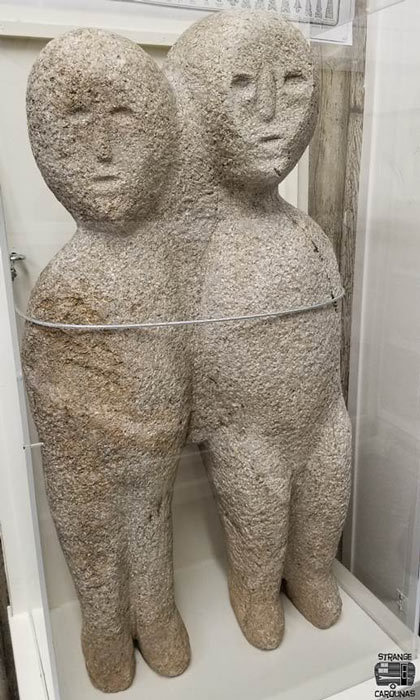
The figures of the alleged Moon-Eyed People. Image via Strange Carolinas.
Like so many aspects of the story, the statue of the two figures are said to represent the Moon-Eyed People, but there is no absolute proof of this. And, like the Moon-Eyed People themselves, there are multiple stories circulating about the origin of the statue with theories ranging from it being a simple sculpture of two people to some believing the Moon-Eyed People were extraterrestrials and this statue was carved as a tribute to them. Museum Director Wanda Stalcup acknowledges the theory of the Moon-Eyed People and the statue’s alleged connection, stating “They were a legend of the Cherokee…The Moon-Eyed People were supposed to be people who only came out at night. They were light-skinned and had big blue eyes." However, Stalcup keeps the door open to all ideas, saying simply that everyone is entitled to their opinion because no one knows what they are.
The Moon-Eyed People have been appearing in spoken word accounts and theories for hundreds of years and despite centuries of speculation as to who they are and where they came from they remain a mystery, unable to be proven or disproven. Perhaps they were Native Americans living with albinism. Perhaps they were descendants of a Welsh prince whose legitimacy has disappeared along with the many years since his arrival. Many people and locations stand strongly by their opinion, but over all the years there is one thing we can say for certain about the Moon-Eyed People.
No one knows who or what they are.
**********************************************************************************
Sources:
David Tibbs. Legends of Fort Mountain The Moon-Eyed People / Prince Madoc of Wales. The Historical Marker Database, 2008. https://www.hmdb.org/m.asp?m=11590
The Moon-Eyed People. North Carolina Ghosts. https://northcarolinaghosts.com/mountains/moon-eyed-people/
Exploring the Mysterious North American Moon-Eyed People. Ancient Origins Reconstructing the Story of Humanity’s Past. 2022. https://www.ancient-origins.net/myths-legends-americas/moon-eyed-people-0016334
Vicky Verma. Moon-Eyed People From Ancient America With Pale Skin Were Afraid Of Daylight, Why? Journal News Online. 2022. https://journalnews.com.ph/moon-eyed-people-from-ancient-america-with-pale-skin-were-afraid-of-daylight-why/
Beth Lawrence. Appalachia’s Lost Colony The mystery of the Moon Eyed settlers. The Sylva Herald and Ruralite. 2020. http://www.thesylvaherald.com/news/article_63be7a46-193a-11eb-bcb1-9b6452791b80.html
Ben Johnson. The discovery of America… by a Welsh Prince? Historic UK. https://www.historic-uk.com/HistoryUK/HistoryofWales/The-discovery-of-America-by-Welsh-Prince/
The Moon-Eyed People. Roadside America. https://www.roadsideamerica.com/story/51476
#husheduphistory#featuredarticles#history#Appalachia#AppalachianHistory#Cherokee#CherokeeHistory#NativeAmericanHistory#GeorgiaHistory#Alabama#AlabamaHistory#Unknown#UnsolvedMysteries#MoonEyedPeople#WelshHistory#weirdhistory#forgottenhistory#strangehistory#oddhistory#historyclass#truth is stranger than fiction#historymystery#historicmystery#myths#legends
6 notes
·
View notes
Text
Lasting Last Stand: The Solemn and Sacred Ceilings of Japan
Japan is one of the oldest civilizations in the world and visiting can take someone back in time. Dotted throughout the country are well over 100,000 temples and shrines, some of which are over 1,000 years old. While these Buddhist temples and Shinto shrines are places of great reverence, sacred worship, and peace, there are a handful of them that tell a terrible tale quietly hidden in plain sight.
In 1598 Toyotomi Hideyoshi was approaching the end of his life, and it was coming after sixteen years of war culminating with Hideyoshi unifying Japan under his rule after more than two centuries of feudal warfare. To ensure that his hard-fought victory would not evaporate after his death he declared that upon his demise his rule would pass down to his son, five year old Toyotomi Hideyori. Obviously the young child could not serve the role, so until he was of age five regents from powerful families were appointed to rule on his behalf while pledging allegiance to Hideyori.
The alliance between the five regents was not strong and animosity, paranoia, and hunger for power soon began to crack the already-tenuous foundation. Ieyasu Tokugawa was arguably one of the most powerful of the regents, and he was firmly against Hideyoshi and his decisions. He quickly sieged Fushimi Castle from Toyotomi Hideyori and placed 2,000 troops there under the command of his trusted ally Torii Mototada. Another of the regents, Ishida Mitsunari, greatly distrusted Tokugawa and his motives and he began to stir problems and rebellions among the warlords in order to prevent Tokugawa from establishing an absolute rule. Mitsunari planned to draw Tokugawa out of Fushimi Castle so he could use his troops to take it back, and the plan worked. Spies informed Tokugawa that approximately 40,000 troops were headed toward Fushimi Castle and Tokugawa commanded Mototada to stay behind and defend the castle, allowing Tokugawa to flee westward in the attempt to quell the fighting incited by Mitsunari and keep his control over the region. When Tokugawa left Fushimi Castle he left Mototada and only 2,000 troops behind to face the approaching 40,000 men led by Mitsunari. He was told to defend the castle at all costs.

A replica of Fushimi Castle constructed in 1964 near the original site in Fushimi. Image via Wikimedia Commons.
Amazingly, Mototada and his 2,000 troops were able to defend the castle against Mitsunari for nearly twelve days despite being incredibly outnumbered in the brutal fighting. On July 30th 1600 the forces of Mitsunari broke through Mototada’s defenses and made their way into the castle, allegedly after being helped by someone on the inside.
The exact sequence of events has been lost to time, but Mototada and his remaining numbers (that has been written as being anywhere from ten to one hundred and seventy men) knew their cause was lost. Allegedly, Mototada came face to face with one of Mitsunari’s riflemen and promptly dared him to cut off his head, and the rifleman obliged, slicing it clean off his shoulders while the remaining men watched. Knowing the castle was lost Mototada’s remaining troops refused the cowardice of capture and amid the fires and turmoil they all committed seppuku, ritualistic suicide. The men each sliced open their own abdomen with a short sword before turning the blade and making a vertical cut upward causing them to bleed to death.
Mitsunari won back the castle, but the war was far from over and in the following weeks Tokugawa defeated Mitsunari’s forces in the decisive battle at Sekigahara. It was a victory that would reshape the history of Japan, Tokugawa Ieyasu became the first shōgun of the Tokugawa shogunate and His family ruled Japan for the next 268 years.
In 1623 Tokugawa had the Fushimi Castle dismantled. There was significant damage to the structure that told of its past, but the most startling sign of the turmoil was on the floor. When the forces of Mototada bled to death in the castle keep, there was so much blood that it deeply stained the floorboards with even bloody footprints still visible in the wood.
Over the course of twenty years Tokugawa and a priest had the wood taken up, placed in storage, and then distributed to multiple temples across Japan. The wood planks were installed in ceilings in order to honor the men who died defending the castle.

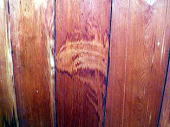
Two examples of the “blood ceilings” of Japan. Image via https://web.archive.org/web/20090705114401/http://www5f.biglobe.ne.jp/~toukondankon/b-toukonn.html
Today the chitenjo, or “blood ceilings” are visible at the temples of Genkoan, Shodenji, Yogenin, and Myoshinji in central Kyoto, Hosenin in the Ohara area, Jinouji in Yawata, and Koshoji in Uji.
More images of the ceilings can be found here and here.
******************************************************************************
Sources:
The Blood Soaked Ceilings of Kyoto by Alan J. Wiren.
https://www.japan-experience.com/all-about-japan/kyoto/temples-shrines/bloody-ceilings
Why Bloody Footprints Line the Ceilings of Kyoto's Genkoan Temple by James Gates.
https://theculturetrip.com/asia/japan/articles/the-chilling-story-behind-a-mass-samurai-suicide-in-ancient-kyoto/
Bloody Ceiling
https://ja.m.wikipedia.org/wiki/%E8%A1%80%E5%A4%A9%E4%BA%95
#husheduphistory#featuredarticles#JapanHistory#JapaneseHistory#HistoryWar#ShogunHistory#KyotoHistory#FamousWar#strangehistory#weirdhistory#forgottenhistory#tragichistory#historyclass#learnhistory#sadhistory#militaryhistory#HistoryofJapan#bloodceilings#memorial#historicmemorial#history#importanthistory#fushimicastle#historyisimportant#truestory#importantstories#tragictale
1 note
·
View note
Text
No Laughing Matter: The Clowns and the Turmoil that Changed Toronto
In the summer of 1855 the city of Toronto was a far cry from the bustling capital city that it is today. Much closer to resembling the Wild West, the city was filled to the brim with bars, liquor shops, and brothels catering to the rotating population of approximately 40,000 people. Mary Ann Armstrong ran one of Toronto’s many “clubs” on the corner of King and Jarvis Streets and the combination bar and brothel was always busy, especially when new faces were passing through town. The sights, sounds, and stories that originated there are incalculable, but on one July night Armstrong’s establishment was the setup for an incident that sounds like a joke but was unfortunately very real with a horrible punchline. “A clown and a fireman walk into a bar…”
On the morning of July 12th 1855 a large group of travelers made their way into Toronto, but these visitors were a little more unusual than the normal passers-by, this was the S.B. Howes' Star Troupe Menagerie & Circus. S.B. Howe was one of the first circus companies to bring their act on tour traveling to one city and taking up residency for a few days before packing up their tents and disappearing from the scene. The circus was only supposed to be in town for two days and after their first performance a group of clowns decided to take in the town, eventually ending up at Mary Ann Armstrong’s building.

Illustration of King Street in Toronto circa 1855. Image via Wikimedia Commons.
The image might sound funny, a group of clowns walking into a rowdy, tough, and intimidating brothel and bar, but these clowns were not to be messed with. Their jobs went far beyond entertaining and included the physical labor of building, breaking down, packing up, and moving their entire community to each city on the tour. They were strong, bold, and did not back down from a fight, which was a recipe for disaster considering the other people visiting Armstrong’s that night.

Advertisement for the circus. Image via torontodreamsproject.blogspot.com/com/.
At this point in time fire departments were not formally established and individual companies formed privately and functioned for profit, racing to fires and charging a price before putting them out. It was not uncommon for rival fire companies to clash in the streets, sometimes requiring local law enforcement to intervene. Only two weeks before the circus came to town one local company, the Hook and Ladder Firefighting Company, was involved in a violent street brawl with another fire company that became known as the Fireman’s Riot. They were an aggressive group, and tonight they were visiting Armstrong’s establishment at the same time as the clowns.
There has never been a singular cause identified for what happened next. One account says that the clowns cut the line to get into the building. Another says one of the firemen named Fraser knocked a hat off the head of a clown named Meyers and refused to pick it up when asked. Others simply say it was a case of someone getting loud with someone else who did not take kindly to their tone. The result was an all-out brawl and by the time the police arrived the firemen were all beaten to a bloody pulp with two of them requiring medical attention at a hospital. The band of clowns simply went back out into the night to continue partying.
The situation was bad enough as is, but the political climate of the area made the conflict cut deeper. Much of Toronto’s population was made up of Irish Catholics but the city government was deeply Irish Protestant and Tory elite, supported by the Orange Order, who were also firmly in the corner of the bloodied Hook and Ladder Firefighting Company. As far as the fire department was concerned the clowns had just declared war.
When the S.B. Howes' Star Troupe Menagerie & Circus came into town they pitched their tents along the waterfront at the site of Fair Green, near the St. Lawrence Market. On the day after the brothel brawl, Friday the 13th, the merchants in the market were few and far between, there was word that something bad was brewing. Slowly they began to arrive to the circus grounds, a large mob of Orangemen of the Orange Order, and before long the rocks began to fly. The circus performers were able to hold back the assault for a short amount of time but when the fire department arrived it was not to help the entertainers, it was to destroy them. The members of the Hook and Ladder Firefighting Company arrived carrying pikes, pipes, and axes. They tore apart the circus tents, beat anyone in their paths, set fires, and knocked over wagons with a bloodthirsty ferocity. Police Chief Samuel Sherwood, a former tavern owner with no formal training, arrived and brought in a handful of constables throughout the day but never put a focused effort into quelling the violence. How could he? He was a part of the Orange Order himself and when later questioned about the level of power he had in his position as Chief his answer was “A very small one indeed…I give orders and instructions to the force, but cannot get them obeyed. As soon as I am out of sight, the men do as they please.” When the Mayor arrived at the scene he took matters into his own hands, wrestling an ax from a fireman who was about to murder one of the clowns and calling in a militia to finally put a stop to the violence. The clowns and other performers took what was left of their belongings and fled the city as quickly as possible.
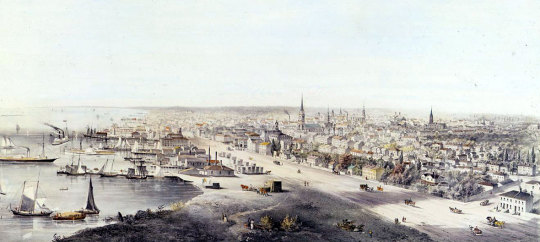
Painting of Toronto showing the site of Fair Green. Image via http://torontodreamsproject.blogspot.com/
The aftermath of the riot was unfortunately familiar. When the Fireman’s Riot happened only weeks beforehand the memories of the police department and the firemen involved were suddenly and inexplicably fuzzy and they could not recall a single member of the Orange Order that was on the scene. One constable said it was too dark out to see any faces and another even said that the entire ordeal was carefully planned so that only people unfamiliar to the police would be involved. The exact same scenario played out again after the attack on the circus clowns and suddenly no one who advanced on the tents could recall anything that happened. Out of the entire mob only seventeen people were ever arrested and when they went to court every single person who attacked the circus that day was acquitted.
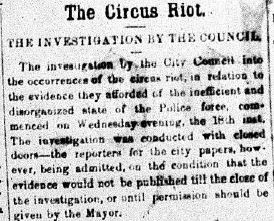
Article about the investigation of the Toronto Circus Riot. Image via torontoist.com.
The official word on what happened may have been hazy but the public saw the corruption very clearly and while they could not create change overnight, the Toronto Clown Riot proved to be a fatal blow to the too-long accepted state of things. After the riot it became much more common to question the conveniently selective memories of the police force that was given absolute power with no form of training. The formerly iron-clad coverups for the actions of the fire departments corroded and began to lose strength. The voices against the Orange Order got louder and louder.
One of the biggest indicators that the public had had enough came with the next election when for the first time in twenty years a mayor was elected that was backed by the Irish Catholics despite the hardest efforts of the Orange Order to prevent it. Reform and organization was needed and in 1858 the first provincially approved board put a restructuring of the new city government and police force into motion. In February of 1859 the entire police force was fired (roughly half that were not part of the Toronto Clown Riot were reinstated), a new chief was brought on board, and finally Toronto had a police force that was out of private hands, nonpolitical, and under close watch by the newly established city government.
The fates of many of the S.B. Howes' Star Troupe Menagerie & Circus clowns are greatly unknown and the clown named Meyers has faded into time. Little could he or any of the clowns imagined on that July night that getting into a fist fight with a gang of firemen in a brothel would lay the foundation for the establishment of Toronto’s first formal police department.
*****************************************************************************
Sources:
“Hidden History: The Toronto Circus Riot” by Lenny Flank. August 20th 2019
https://www.dailykos.com/stories/2019/8/20/1870769/-Hidden-History-The-Toronto-Circus-Riot
“The Toronto Circus Riot of 1855 — the day the clowns picked the wrong Toronto brothel” by Adam Bunch. October 2nd 2012.
http://spacing.ca/toronto/2012/10/02/the-toronto-circus-riot-of-1855-the-day-the-clowns-picked-the-wrong-toronto-brothel/
“How a Fight With Clowns Led to the Birth of Modern Policing in Toronto “ by Patrick Metzger. September 12th 2013.
https://torontoist.com/2013/09/how-a-fight-with-clowns-led-to-the-birth-of-modern-policing-in-toronto/
“Infamous Clown Brawl in Brothel Gets Entire Toronto Police Force Fired “ by Sean Kernan. November 29th 2021.
https://medium.com/lessons-from-history/infamous-clown-fight-in-brothel-gets-entire-toronto-police-force-fired-ceca014addc6
“Clowns fighting firemen in Canada in 1855.” opposite-lock.com/topic/22965/clowns-fighting-firemen-in-canada-in-1855
“The Toronto Circus Riot of 1855 “ http://torontodreamsproject.blogspot.com/2012/08/the-circus-riot.html
#HushedUpHistory#featuredarticles#CanadianHistory#CanadaHistory#TorontoHistory#TorontoFireHistory#TorontoPoliceHistory#CircusHistory#LegalHistory#FamousRiot#CanadaRiot#Clowns#weirdhistory#strangehistory#forgottenhistory#truestory#truthisstrangerthanfiction#historyclass#weirdstory#strangestory#history#history class
2 notes
·
View notes
Text
Keep Him Safe: The Awful Exchange of Leonarda Cianciulli
From early on Leonarda’s life was filled with tragedy and deep pools of darkness, but by the time she was forty-five years old it may have appeared like the bad years were behind her. According to all outward appearances she had four children that she adored, her family was freshly settled into a new home, she opened a small shop that proved to be successful, and she found friends in her neighbors. It seemed like there was very little to dislike about Leonarda. After all, she was friendly, generous, wise, and she was known to lend a helping hand to people chasing their dreams that reached far outside their town of Correggio. And then there were her baking. Her treats were enjoyed by many, but only because no one knew the truth about them.
Leonarda Cianciulli was born in Montella in the Kingdom of Italy on April 18th 1894. In her early life she attempted suicide twice before marrying a registry office clerk named Raffaele Pansardi in 1917. Cianciulli’s mother immediately disapproved of the union and there were already plans for Leonarda to marry someone else, but she refused. According to Leonarda’s memoir, the marriage to Pansardi caused her mother to put a curse on the pair before they moved to his hometown of Lacedonia. Some might say the curse was successful, between 1917 and 1939 Cianciulli became pregnant seventeen times and of the seventeen three were lost and ten of the children died at a very young age. In 1927 Cianciulli spent just over a year in prison for fraud after creating a fake account with a sizeable amount of money in a ledger at the bank where she worked as an evening cleaner. On July 23rd 1930 the Irpinia earthquake struck and totally destroyed her home forcing the family to relocate to Correggio. Looking for answers to all the turmoil in her life Leonarda sought the insight of at least one fortune teller. The news was not good, not only was she told all of her children would die young, but a palm reader also told her that "In your right hand I see prison, in your left a criminal asylum."

A scene of devastation after the Irpinia Earthquake. Image via Wikimedia Commons.
After moving to Correggio Leonarda seemed to have entered a new chapter in her life. The people of Correggio welcomed her and her family and she and Raffaele became well-liked by the townspeople. After a lifetime of broken connections and instability Leonarda quickly found herself in an unfamiliar position: having friends. There were dinner parties, casual visits with neighbors, and Leonarda was well respected for her wisdom, insight, wit, and skills. The extreme paranoia and anxiety she had developed over the course of her life may have actually started to dissipate while she started new hobbies like writing poetry. She even re-opened the little shop attached to her new home and became successful at selling her homemade goods like soap. But, like so many other times in her life, turmoil was coming.
When World War II broke out nearly four million Italians joined the military to serve their country and among them was Giuseppe Pansardi, Leonarda’s eldest and favorite child. For an obsessively over protective mother, the thought of losing a child on the battlefield could have been suffocating, but for the psyche of Leonarda it was absolutely catastrophic. She remembered that the fortune teller said all her children would die young and she had already lost thirteen of them. No matter what she had to do, she was not going to lose her son to war. The solution was clear to her; she would offer human sacrifices in exchange for his protection.
The first was Faustina Setti, a woman who often confided in Leonarda that she desperately wanted to find a husband. The confession wasn’t overly unusual, the seventy-six year old Faustina was good friends with Leonarda and the two saw each other on a regular basis. On one particular visit with her friend Faustina was met by a very excited Leonarda who had some astounding news for her, she found her a husband, a man in the city of Pula that she had been exchanging letters with. She sent him a photograph of Faustina and he immediately said that not only did he want to meet her, he wanted her to be his wife. All of this should have seemed bizarre to Faustina but she was so overcome with joy at the news of a husband that no questions or hesitation came to mind. Leonarda was thrilled for her friend and offered to plan the entire trip to Pula for her. But she had one very specific rule that Faustina had to follow. She told her to be careful, that friends and family would try to discourage her from going. In order to avoid any problems Leonarda instructed her to write a series of letters to them in advance, assuring them she was safe in Pula and very happy. Leonarda promised to mail them for her. It was all for the best. It was a total lie.
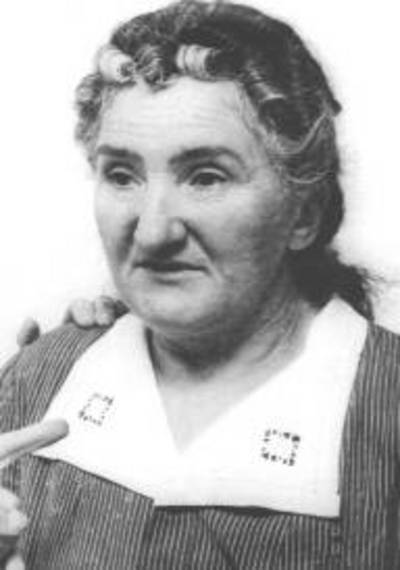
A later photograph of Leonarda. Image via https://horroresrevelados.wordpress.com/2017/03/20/leonarda-cianciulli-creaba-jabones-con-humanos/
On the morning of Faustina’s departure she went once again to Leonarda’s home. It was early, quiet, and Faustina was sitting at her friend’s table with shaking nerves and empty pockets. Leonarda had made her dreams come true, the least she could do was give her all of her life savings. As usual, Leonarda was there for her friend, she handed her a glass of wine to calm her nerves. It worked quickly. Faustina became calmer…and calmer…and her eyes and limbs got heavier…and heavier. We will never know if Faustina saw Leonarda approaching her with the ax. She thought she entered the home as a friend, she had no idea she was Leonarda’s first sacrifice.
Leonarda was accustomed to butchering animals and she used those skills to cut Faustina Setti’s body into nine pieces. Her body parts were put in a pot with over ten pounds of caustic soda. The chemical turned the remains into a thick dark sludge that Leonarda disposed of in a nearby septic tank. But then there was the blood, there was an entire basin of it. Leonarda waited until it coagulated before putting it in her oven to dry out. Once it was ready she ground it up. Then she got rid of it…along with some flour, sugar, chocolate, milk, eggs, and margarine. She kneaded the dried blood of Faustina into the dough and proceeded to make a batch of her famous tea cakes which she generously shared with her friends.
But was the sacrifice of Faustina enough to ensure the safety of her son?
By August of 1940 Francesca Soavi was in need of help. The former schoolteacher had quit her job to take care of her ill husband and when he died she was left with very little. Unable to find work she sought out Leonarda, after all she heard about how Leonarda had found Faustina a husband and made her dreams come true. Francesca met Leonarda and amazingly, she said that she was able to help. As luck would have it Leonarda knew of a school in the city of Piacenza, and they had a job opening. It was a very sought after position but Leonarda told her not to worry, she would make magic happen. Sure enough, a few weeks later Leonarda gave Francesca the happy news that she got the mystery dream job. All she had left to do was pack and write letters in advance to her friends and family telling them she was happy and safe. She would not even have to worry about mailing them, Leonarda’s son would take care of that for her.
On September 5th 1940 Francesca arrived at Leonarda’s home in the early morning just before she departed for Piacenza. She wanted to thank her once again for helping her find a job and getting her back on her feet. Leonarda handed her a celebratory glass of wine. Once again Leonarda’s guest started to feel weak and once again her host grabbed the ax. Francesca met the very same fate as Faustina with her broken down, liquified remains being tossed into the septic tank and her blood being baked into tea cakes. Leonarda’s second sacrifice was complete.
As Giuseppe’s departure date loomed closer Leonarda’s worry over if she had done enough to ensure his safety might have been unbearable. She needed to find another sacrifice but this time she did not have to look far. Virginia Cacioppo was a celebrity in Correggio. She was a former opera singer who once sang at the famed La Scala opera house in Milan and her friends and neighbors often heard her tales of lavish living so many years ago. Now after spending a number of years away from the spotlight she missed her former life and her close friend Leonarda was happy to help her. Before long Virginia had good news, Leonarda found her a job as a secretary for an impresario who organized the kind of artistic events that she was so familiar with and missed so dearly. She had to act quickly though, the job was in Florence and she had a lot to do before moving and re-igniting her life.
On the morning of September 30th 1940 Virginia was ready to go, but she could not leave without thanking her friend Leonarda for all of her amazing help. She brought along her belongings and, of course, the letters that Leonarda told her to write in advance that would be mailed later telling everyone about her wonderful new life in Florence. Leonarda offered her a glass of red wine.
Once Virginia was dead on the floor Leonarda started the process again. The body was cut into pieces…the blood was put in a basin to dry for tea cakes…but this time was slightly different. The previous two times Leonarda put the body parts and the caustic soda in the pots the experiment went totally wrong and her friends ended up in the septic tank. This time it worked, according to Leonarda when she recalled the visit later on:
“She ended up in the pot, like the other two...her flesh was fat and white, when it had melted I added a bottle of cologne, and after a long time on the boil I was able to make some most acceptable creamy soap. I gave bars to neighbors and acquaintances. The cakes, too, were better: that woman was really sweet.”

Image via https://horroresrevelados.wordpress.com/2017/03/20/leonarda-cianciulli-creaba-jabones-con-humanos/
Leonarda may have thought her third sacrifice was a success and further ensured the safety of her son, but with the killing of Virginia she made a very big mistake. Her two previous victims, Faustina and Francesca, had families that were located far from Correggio and did not have anyone close by to notice that something was amiss, especially when they were still receiving letters from them. This was not the case with Virginia, she had a sister-in-law in town named Albertina Fanti who did not believe for an instant that she had left to pursue a new job. It was more than a simple hunch that Virginia would not up and leave. It was the added fact that the last time she saw Virginia she was walking into Leonarda’s home and shortly after her disappearance her clothes started popping up for sale in Leonarda’s shop.
The accounts of how Leonarda was arrested vary with some saying Albertina had to go to the police in Reggio Emilia after the local police in Correggio dismissed her. Some say she was questioned more than once and it was only after a bank voucher belonging to Virginia was traced back to Leonarda that her home was searched. Others say the items that brought her down were the letters from the three women, all with a similar story and all mailed after they arrived at Leonarda’s home and “went away” to their bright new futures. Law enforcement might not have known what they were facing when they entered Leonarda’s home to question her, but they probably did not expect what happened. The five-foot-tall forty-six year old woman casually confessed to killing the three women, cutting them into pieces, turning their flesh into discarded sludge and admired soap, and baking their blood into tea cakes. Reports state that during one search of her property the septic tank was searched and inside was found small portions of bone showing evidence of the soap-making process and a denture of fourteen teeth matching the one worn by Faustina Setti.
Leonarda was arrested but she did not see the inside of a courtroom for six years while the war raged on and her son Giuseppe, her “miracle child” that she committed such horrors for, fought in the army. While in prison attempts were made to determine if she was actually a cold-blooded killer or if she was legitimately insane. One of the most renowned Italian psychiatrists, Director of the Criminal Asylum of Aversa, Filippo Saporito, undertook this task and asked Leonarda to write about her life. Several years later he was presented with a memoir that was almost 800 pages long and entitled Confessions of a Bitter Soul filled with everything from passages from the Gospels to the grisly details on how she turned the bodies of the three women into tea cakes and soap.

Mugshot of Leonarda Cianciulli. Image via Wikimedia Commons.
According to the Criminology Museum in Rome when the trial began not everyone was so sure Leonarda was the only person responsible for the crimes. These were no simple murders and doubt began to grow that she could have killed the women and done the dismembering of the corpses herself. With suspicion growing the eyes of the courtroom began to shift over to the only other person that they felt could have been involved, Giuseppe. When questioned about his role in the murders Giuseppe admitted to mailing the letters for his mother, but he said he did not know anything about them. With the accusations creeping closer toward her son Leonarda became aggressively adamant he was not involved in the killings, even telling the courtroom to bring her a fresh corpse from the morgue and she would show them all how she did it right then in there, “I cut here, here and here in less than 20 minutes everything was done, including cleaning. I might as well prove it now.”
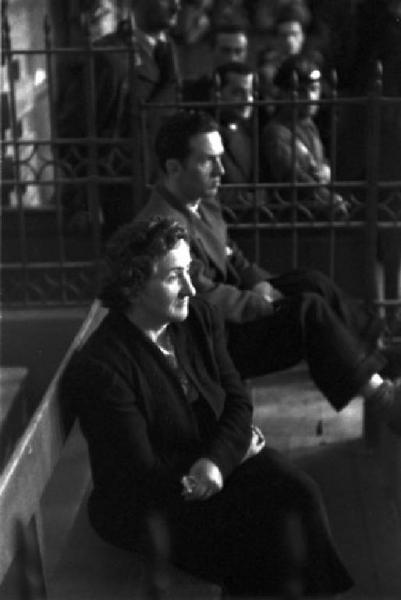
Leonarda Cianciulli during her trail. Image via https://murderpedia.org/female.C/c/cianciulli-leonarda-photos-2.htm
As the examination continued it became clear that Leonarda was their only killer with her even correcting the prosecutor on the finer details of her crimes. She was matter-of-fact, candid, and completely without remorse. At one point telling the courtroom “I gave the copper ladle, which I used to skim the fat off the kettles, to my country, which was so badly in need of metal during the last days of the war...."
The trial of Leonarda Cianciulli only took three days and the verdict was no surprise to anyone. She was convicted of the murders and was sentenced to thirty years in prison and three years in a criminal asylum. According to a nun who knew Leonarda during her imprisonment she was a quiet, calm, prisoner making the welcome speeches to visiting ministers and spending her time crocheting, writing, and baking sweets that the other prisoners refused to eat.
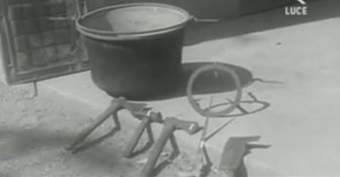
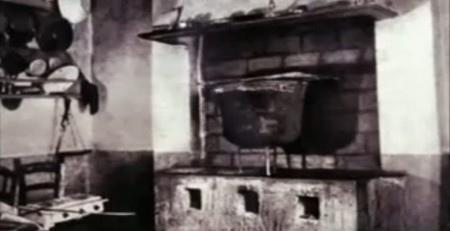
The tools allegedly used by Leonarda in her crimes.
Images via https://murderpedia.org/female.C/c/cianciulli-leonarda-photos-2.htm and https://www.letturefantastiche.com/la_saponificatrice_di_correggio.html
Leonarda Cianciulli died in the asylum on October 15, 1970 at the age of seventy-six. Her body was returned to her family and buried in a common grave of a local cemetery.
Over eighty years after the murders there are still many questions about Leonarda Cianciulli, “The Soap-Maker of Correggio.” What made her believe the answer to her son’s safety was human sacrifice? Did she really do what everyone says? There are some that say it would have been impossible for her to turn the remains of the women into tea cakes and soap inside her own home, but others say the evidence is clear. Some question her own accounts of the murders and wonder if she exaggerated everything to convince the court she was insane in order to avoid the death penalty. A maid allegedly spoke up decades later about seeing the body parts hidden in parts of the house. There will forever be some details that remain foggy but what is absolutely certain is that three women walked into the home of Leonarda Cianciulli excited by the promise of a new life, they never left, and the only traces of them ever found were in the septic tank, exactly where Leonarda said they met their end. Also found in the home were a cauldron, an ax, a hammer, a hacksaw, a kitchen cleaver, and trace amounts of blood in multiple rooms of the house.
The cauldron, axes, hacksaw, and knives used by Leonarda were obtained by the Criminology Museum in Rome and remained on display until the museum’s closure.
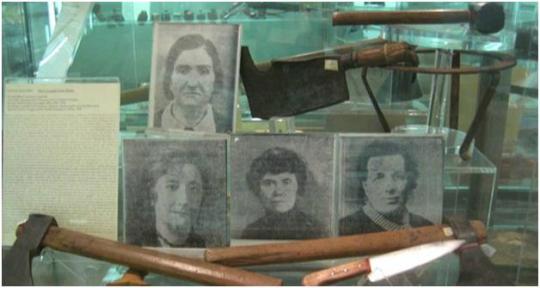
Portion of the exhibit on Leonarda in the Criminology Museum in Rome (now closed.) Image via https://allthatsinteresting.com/leonarda-cianciulli
***********************************************************
Sources:
“Foreign News: A Copper Ladle" Time Magazine published June 24th 1946.
“How Serial Killer Leonarda Cianciulli Made Her Victims Into Soap And Teacakes” by Katie Serena. Published January 29, 2018. allthatsinteresting.com/leonarda-cianciulli
“Leonarda Cianciulli: The Serial Killer Who Turned Her Victims into Soap” by Dan Hendrix vocal.media/criminal/leonarda-cianciulli-the-serial-killer-who-turned-her-victims-into-soap
“WWII Serial Killer Mom Sacrificed Victims to Keep Her Son Safe at War” by Karen Harris historydaily.org/wwii-serial-killer-mom-sacrificed-victims-to-keep-her-son-safe-at-war/4
“The Cianciulli case” www.focus.it/cultura/storia/545745165-il-caso-cianciuli-32653
“Murder: Cianciulli case” www.museocriminologico.it/index.php/2-non-categorizzato/120-omicidi-caso-cianciulli2
The Deadly Soap Maker of Correggio by Genovena Ortiz. True Crime Explicit Volume 6. Sea Vision Publishing 2022.
#HushedUHistory#featuredarticles#history#ItalianHistory#CrimeHistory#LegalHistory#TrueCrime#FamousTrueCrime#horrorhistory#horrorstory#forgottenhistory#strangehistory#tragichistory#truehorror#sadhistory#scarystory#weirdhistory#shockinghistory#shockingstory#truth is stranger than fiction#scary#tragictale#terrifying#historyclass
2 notes
·
View notes